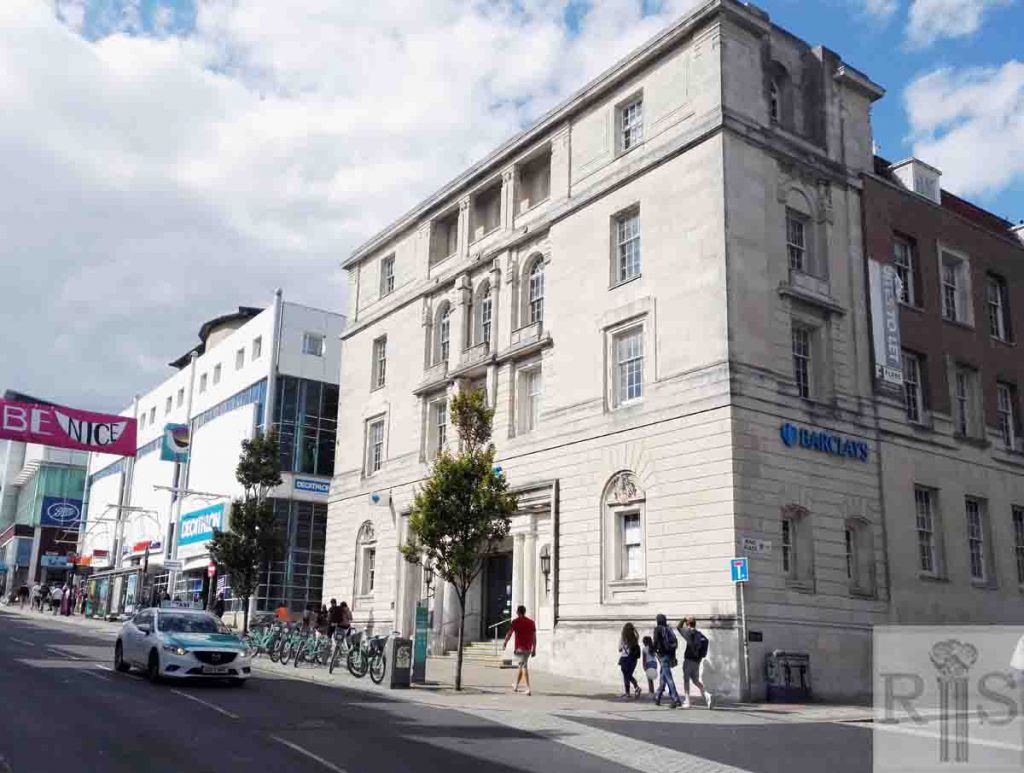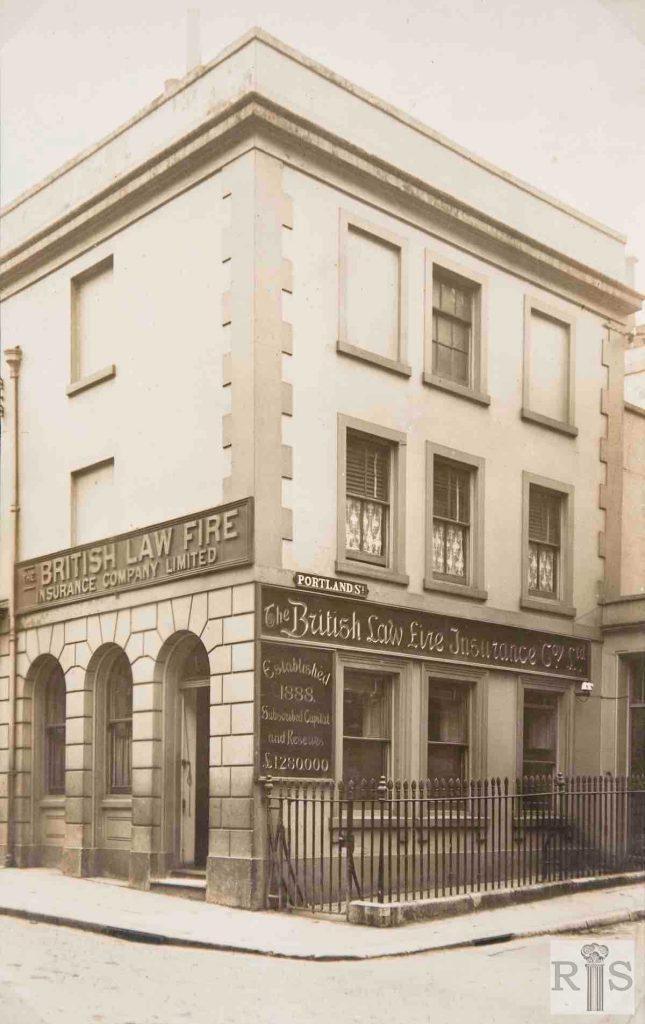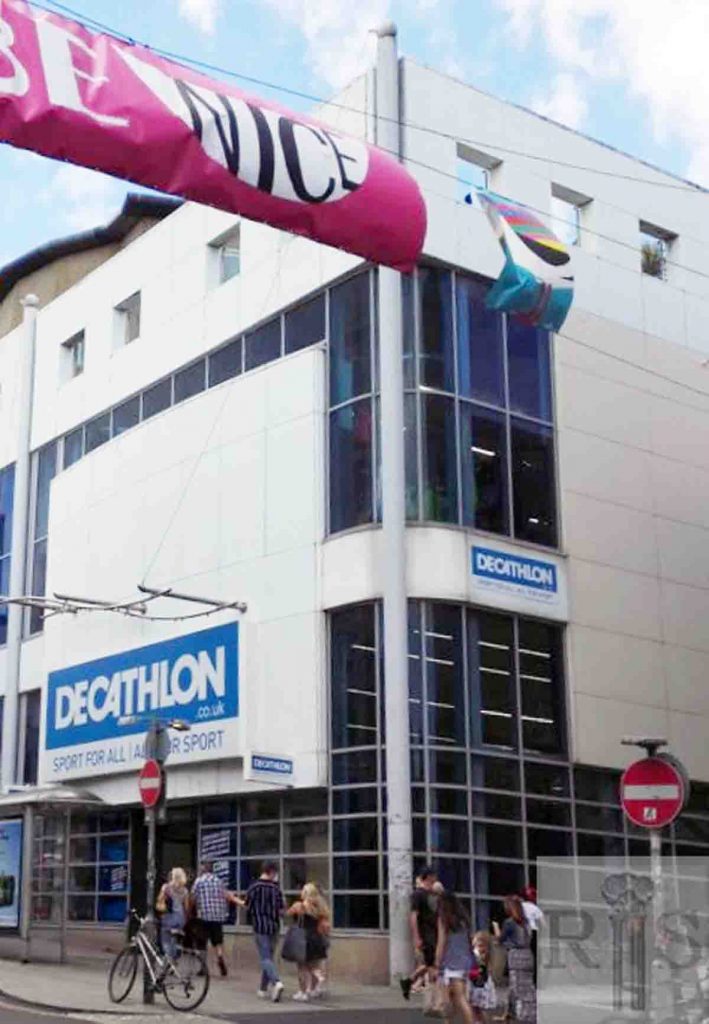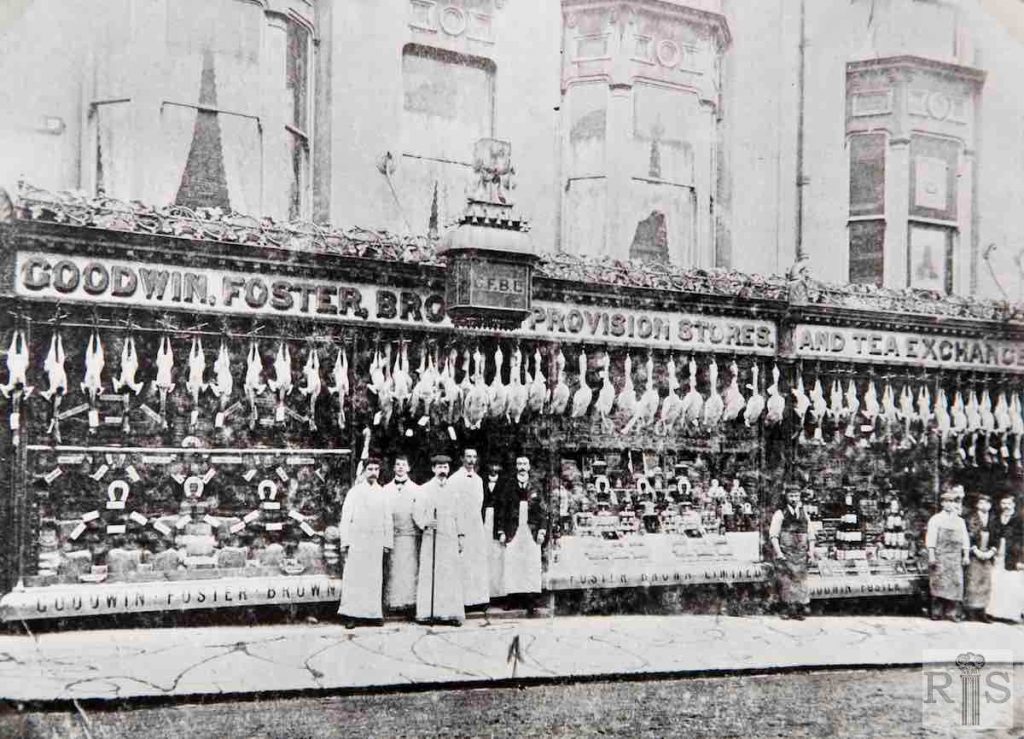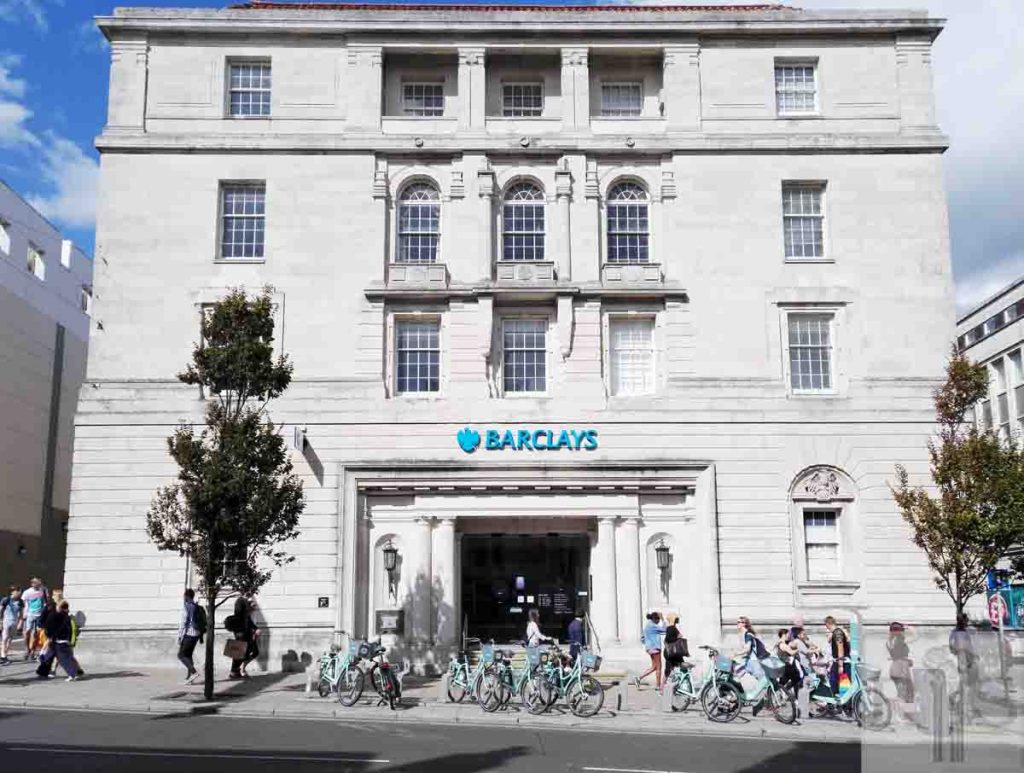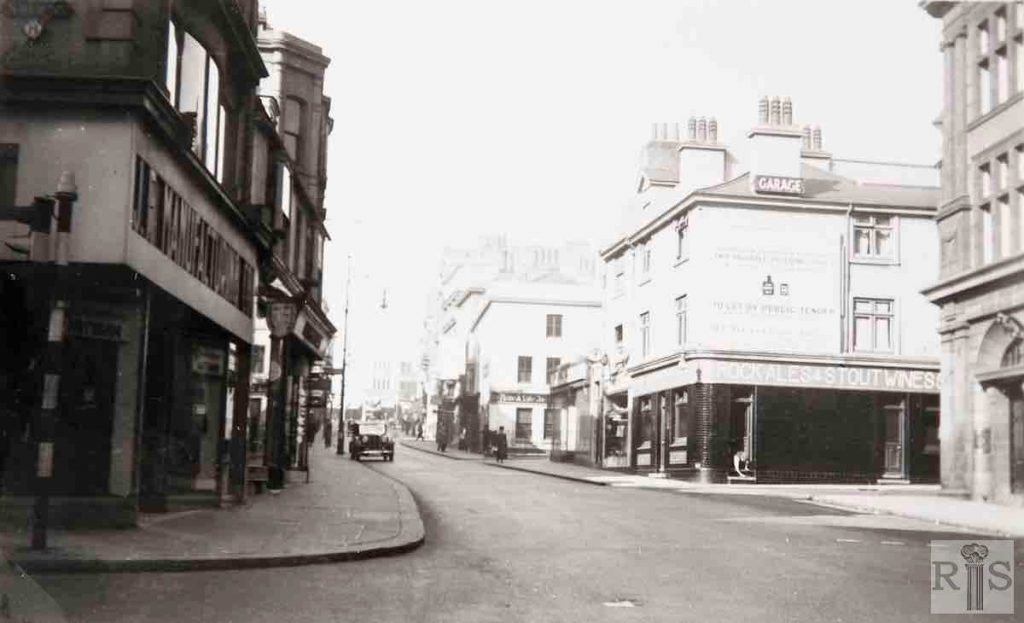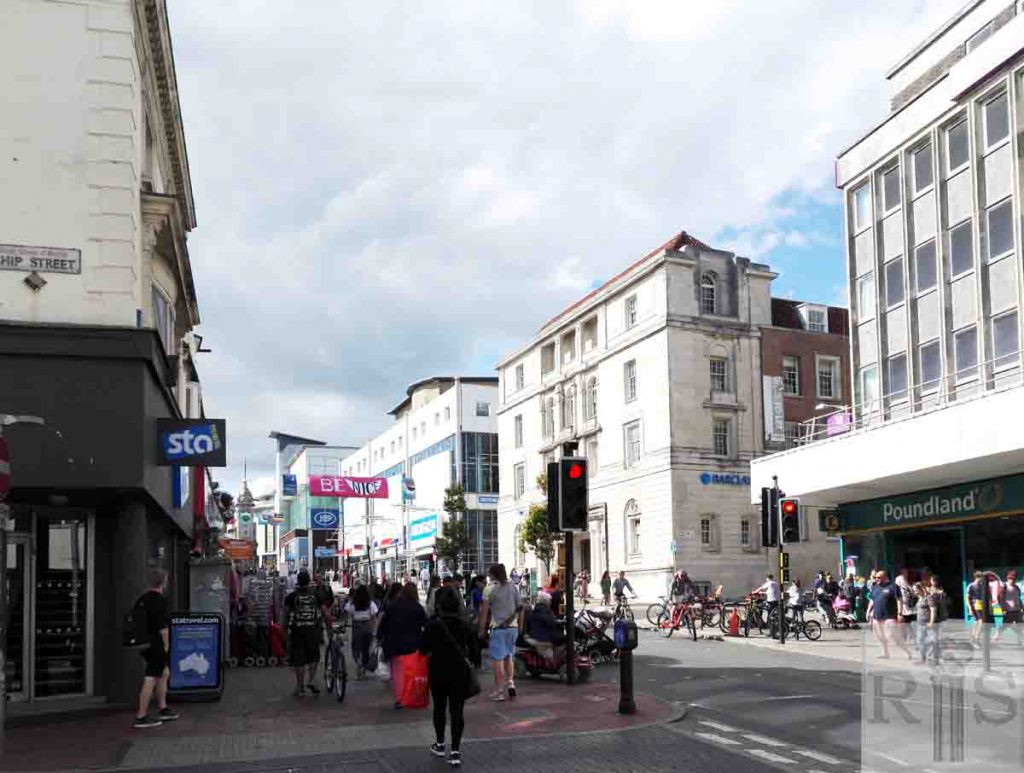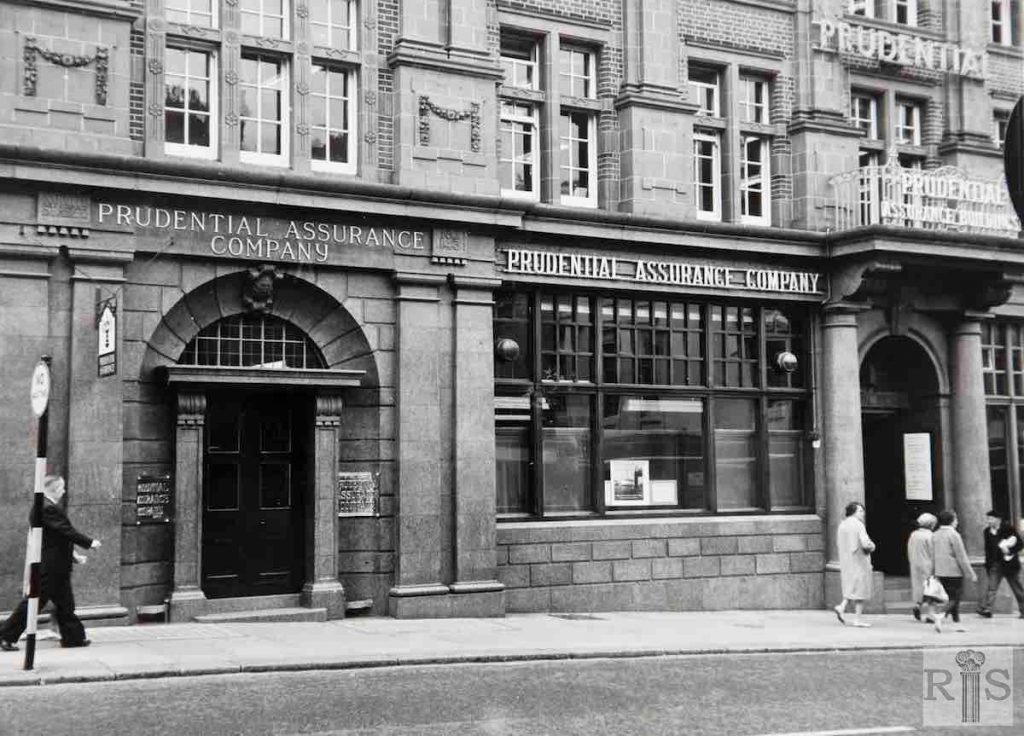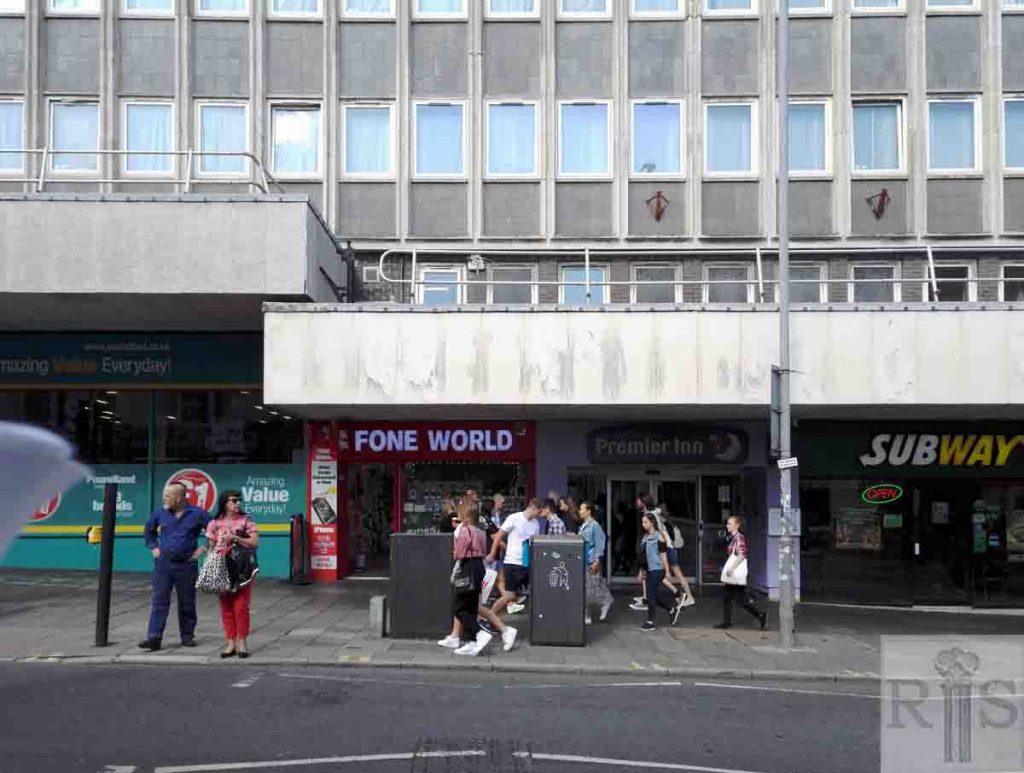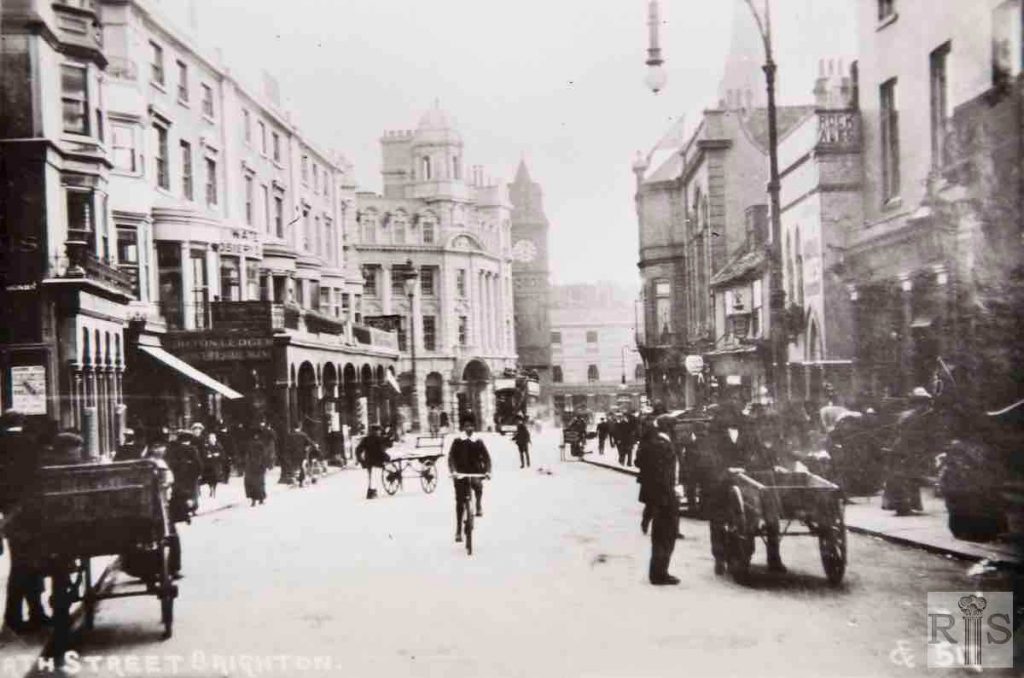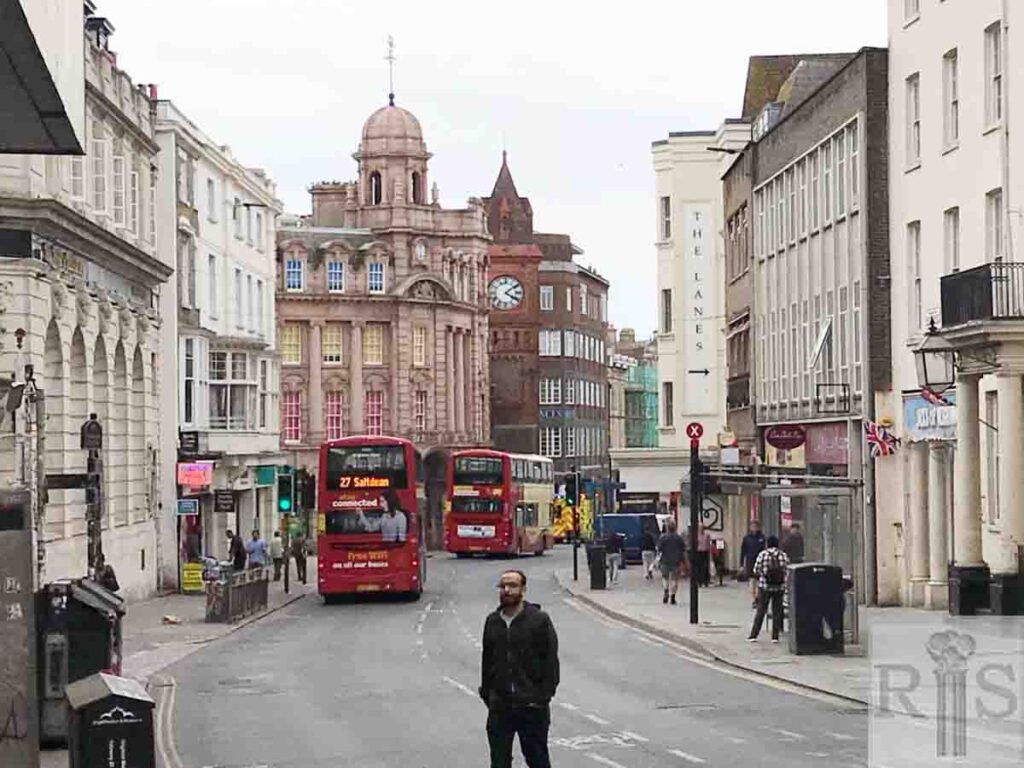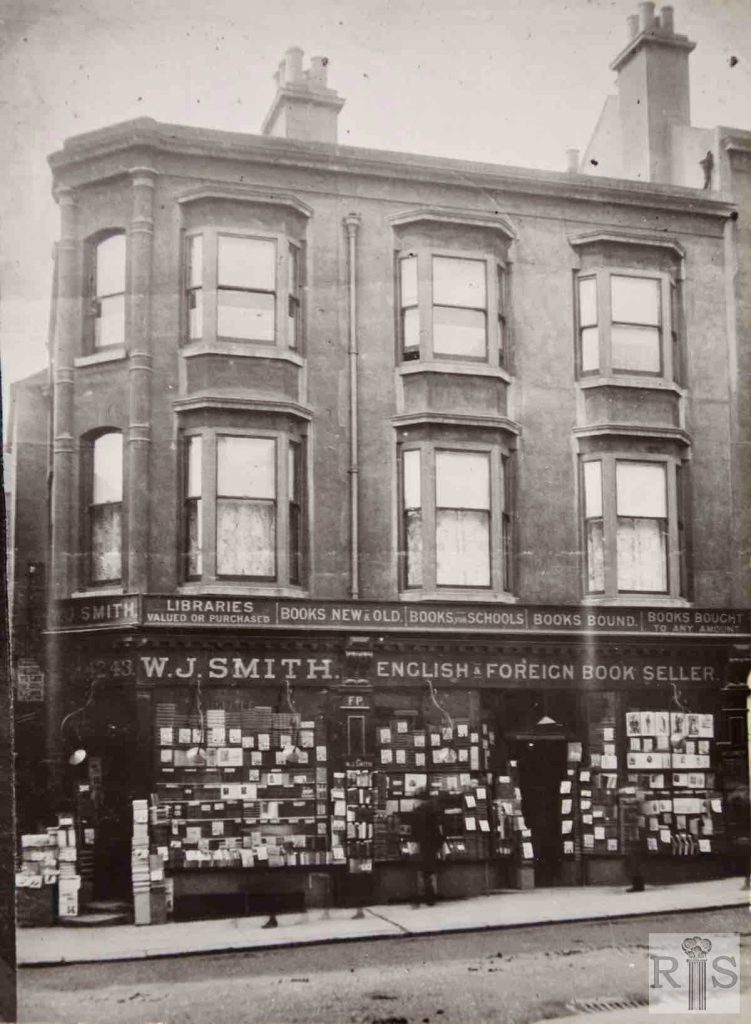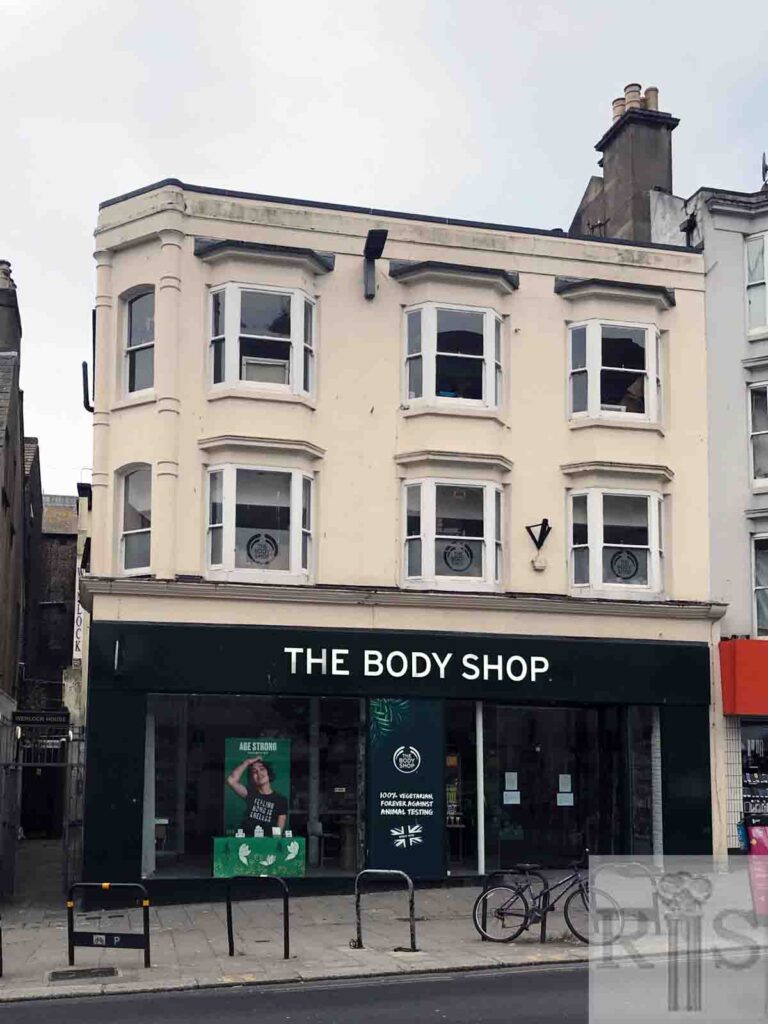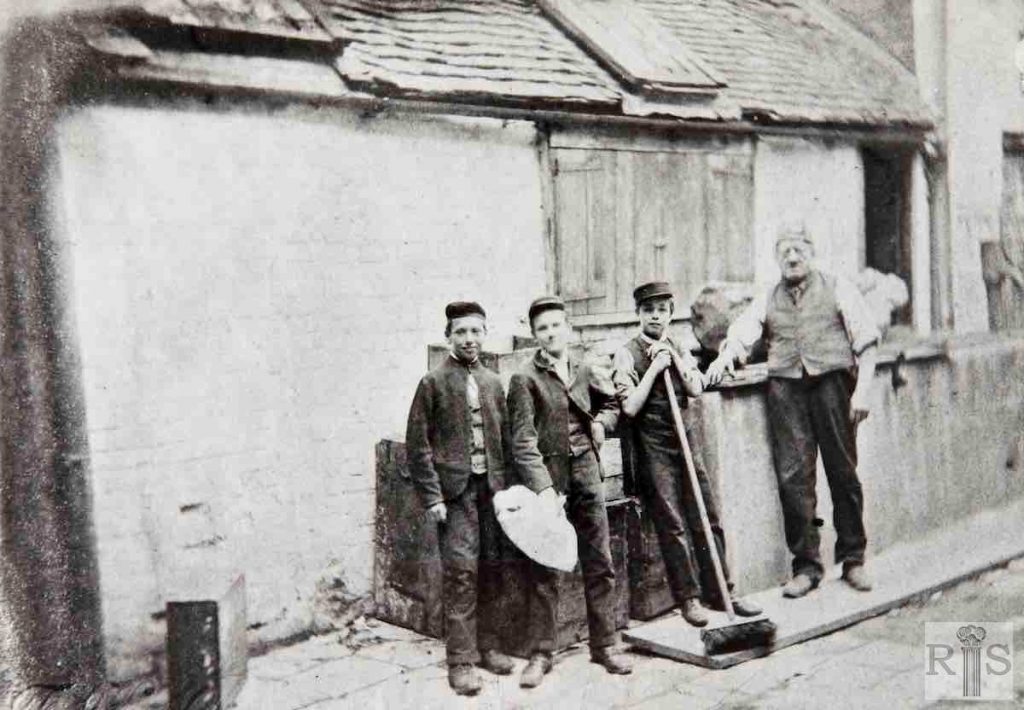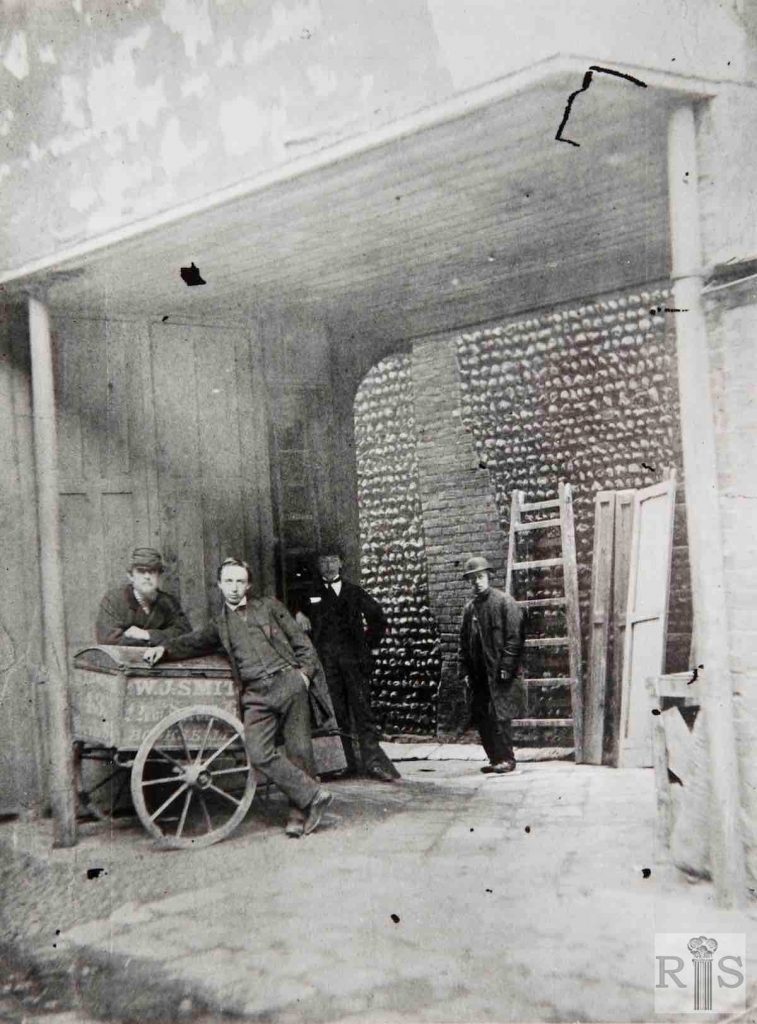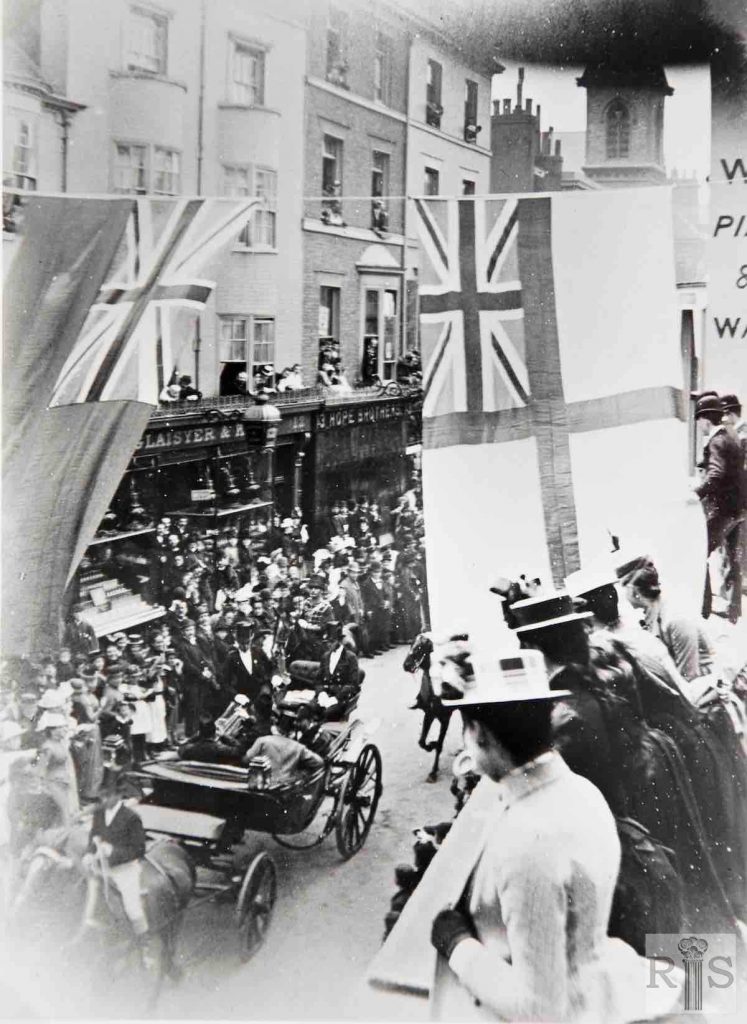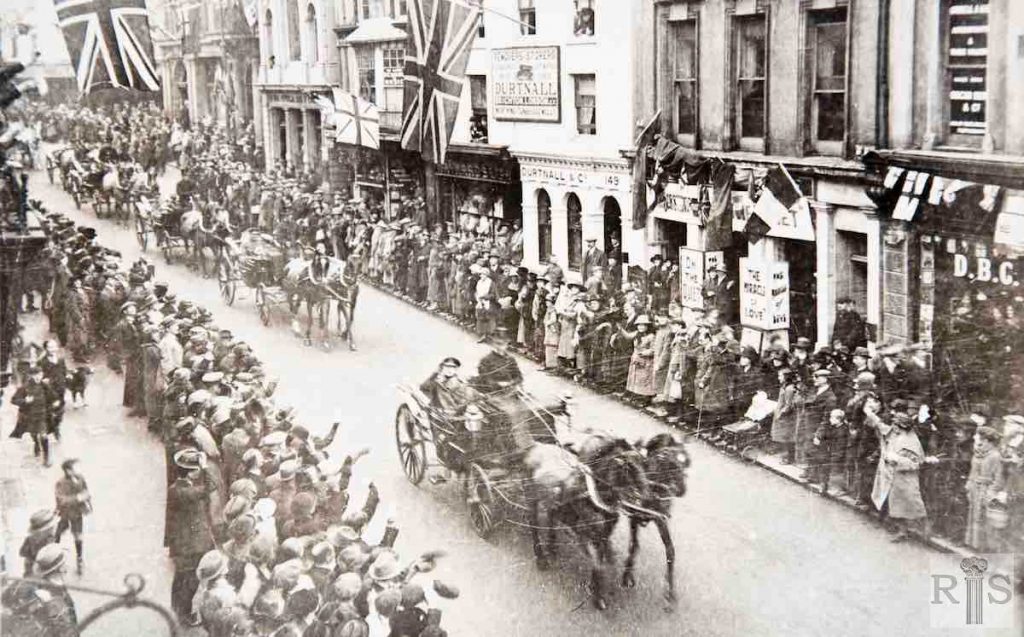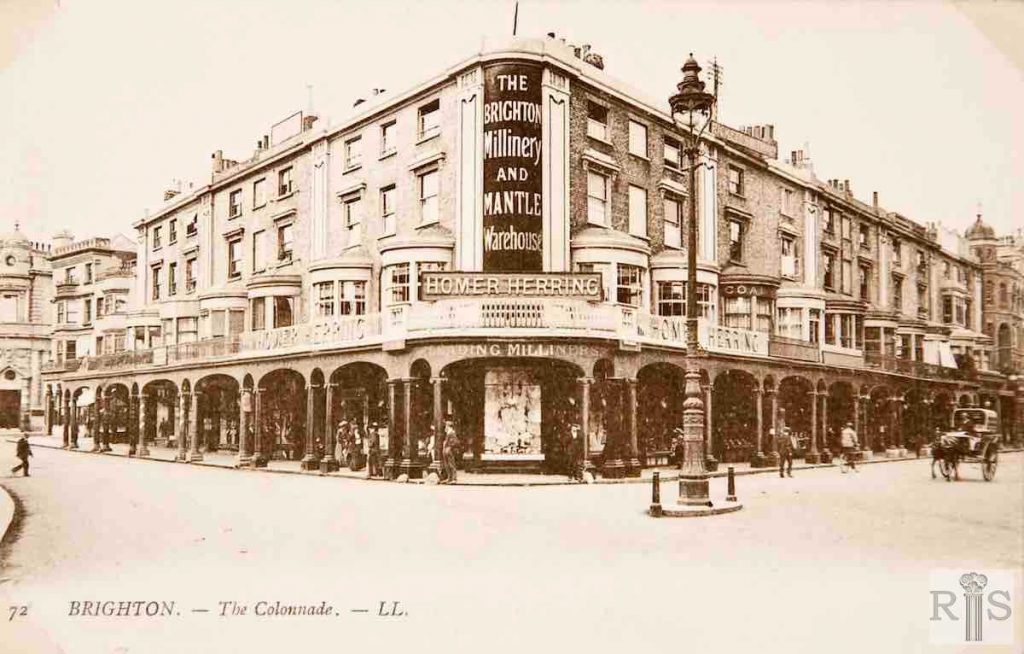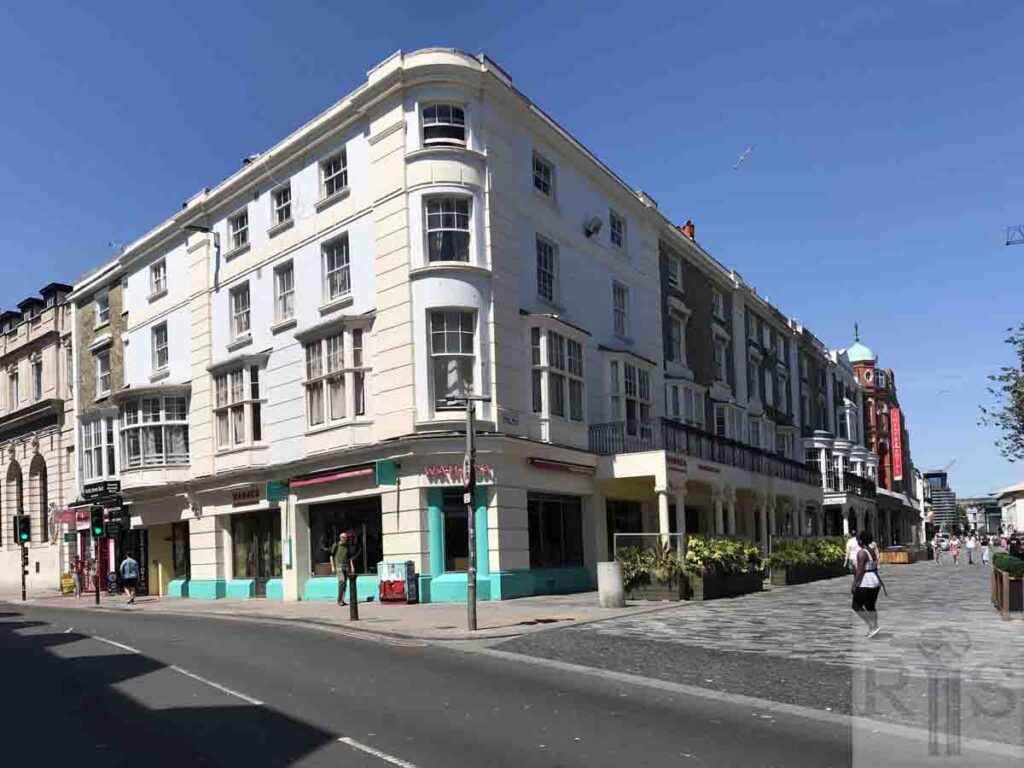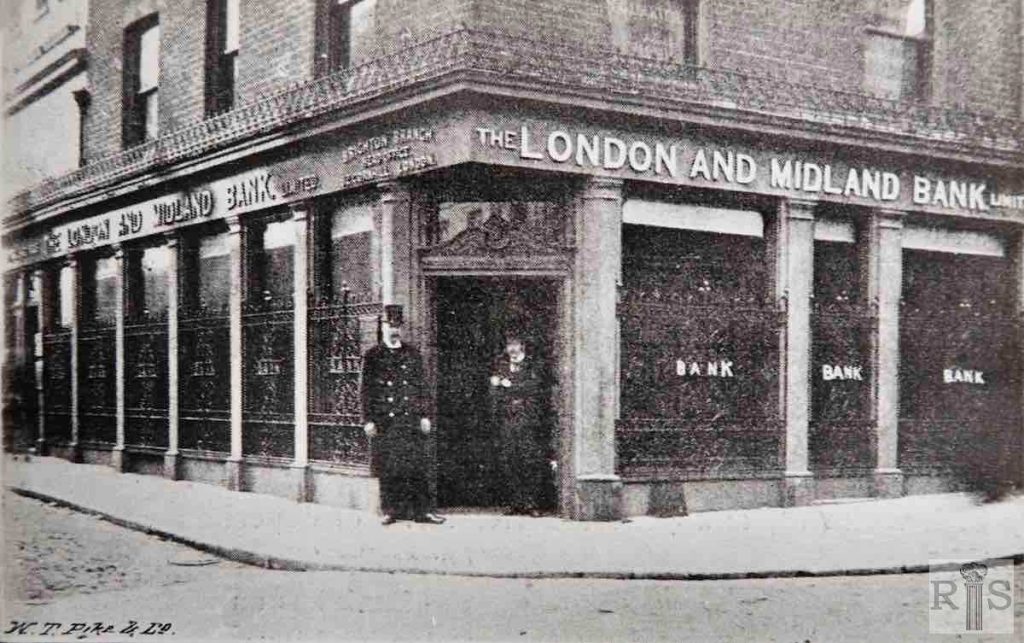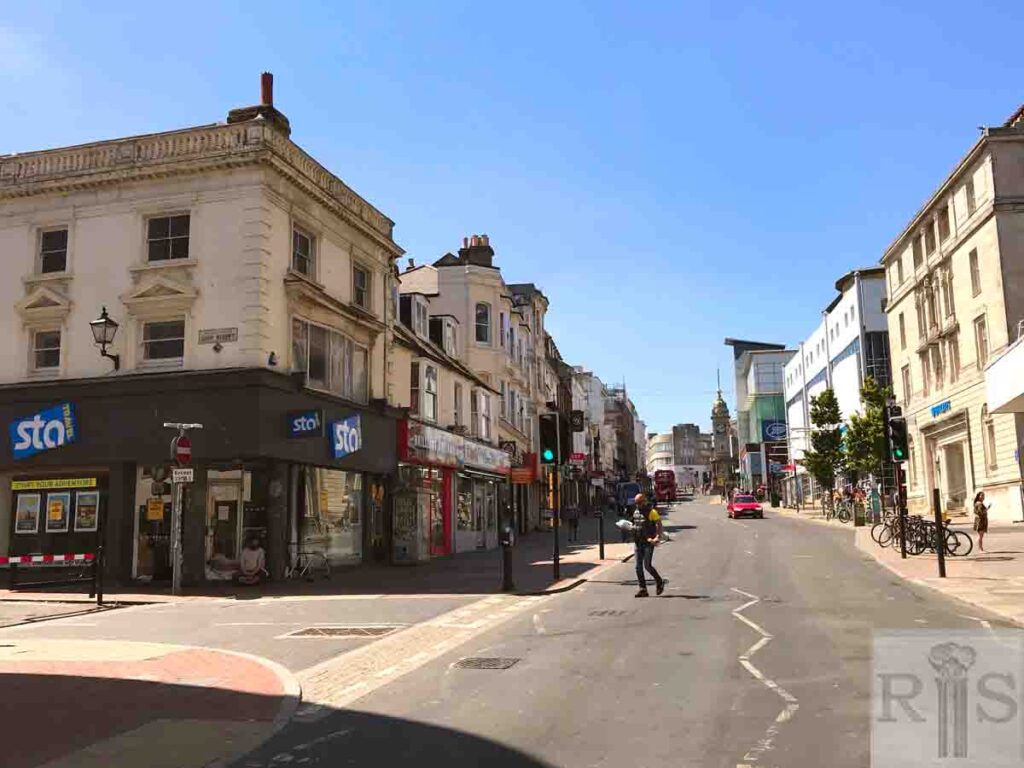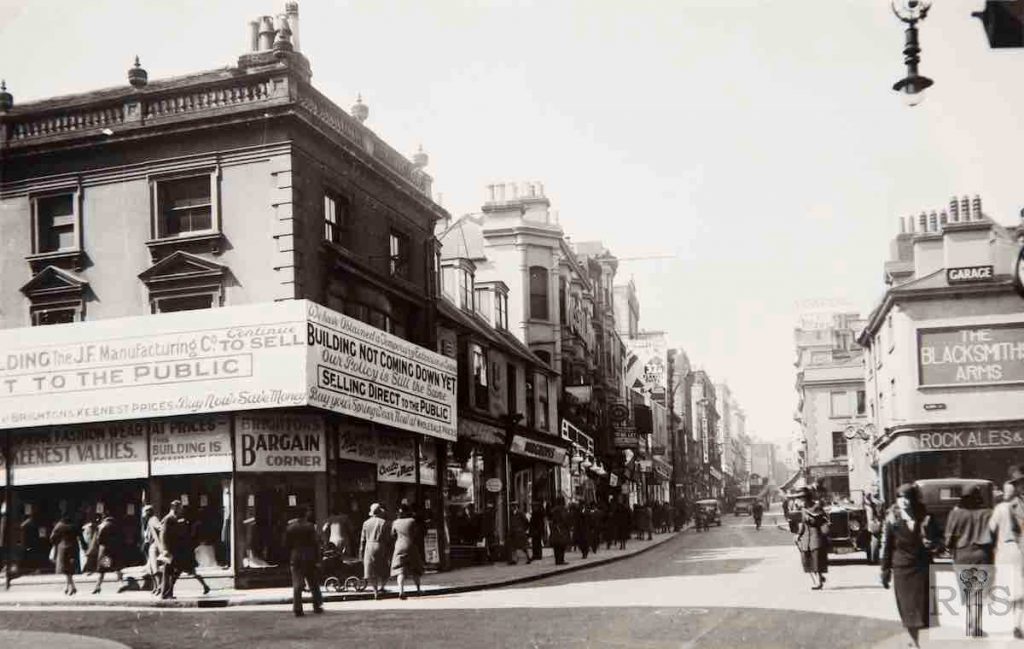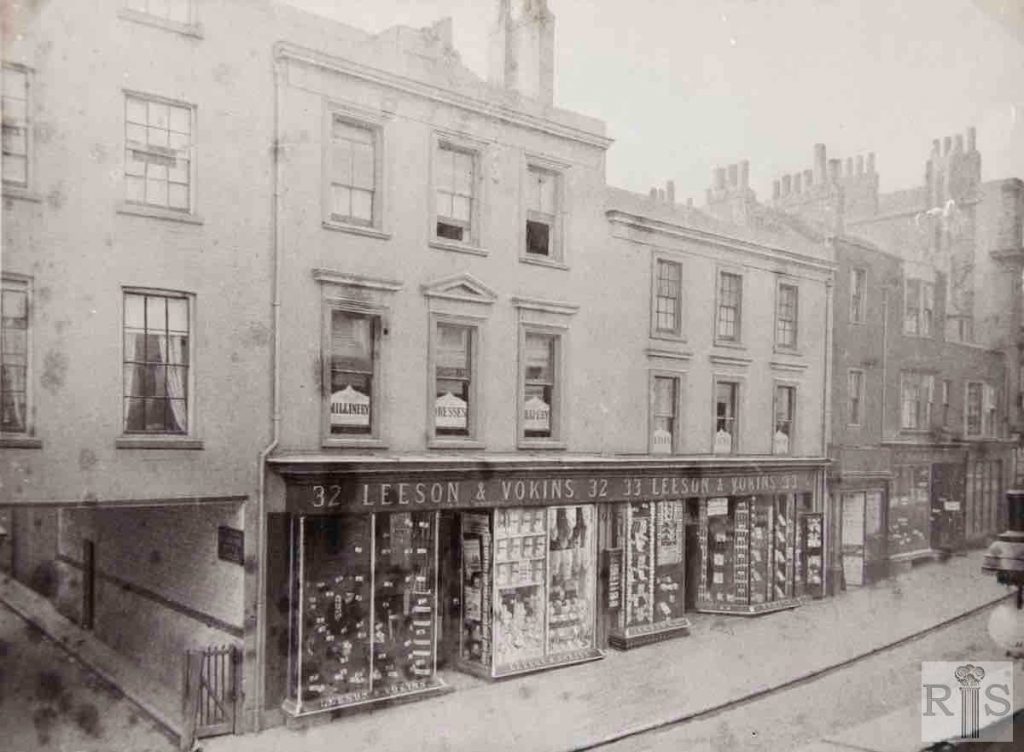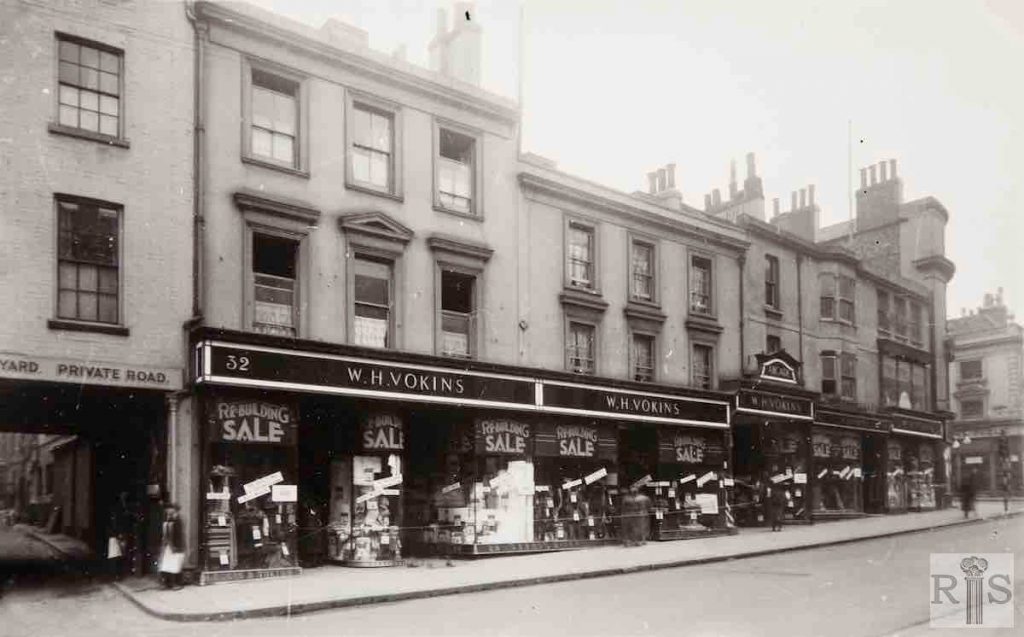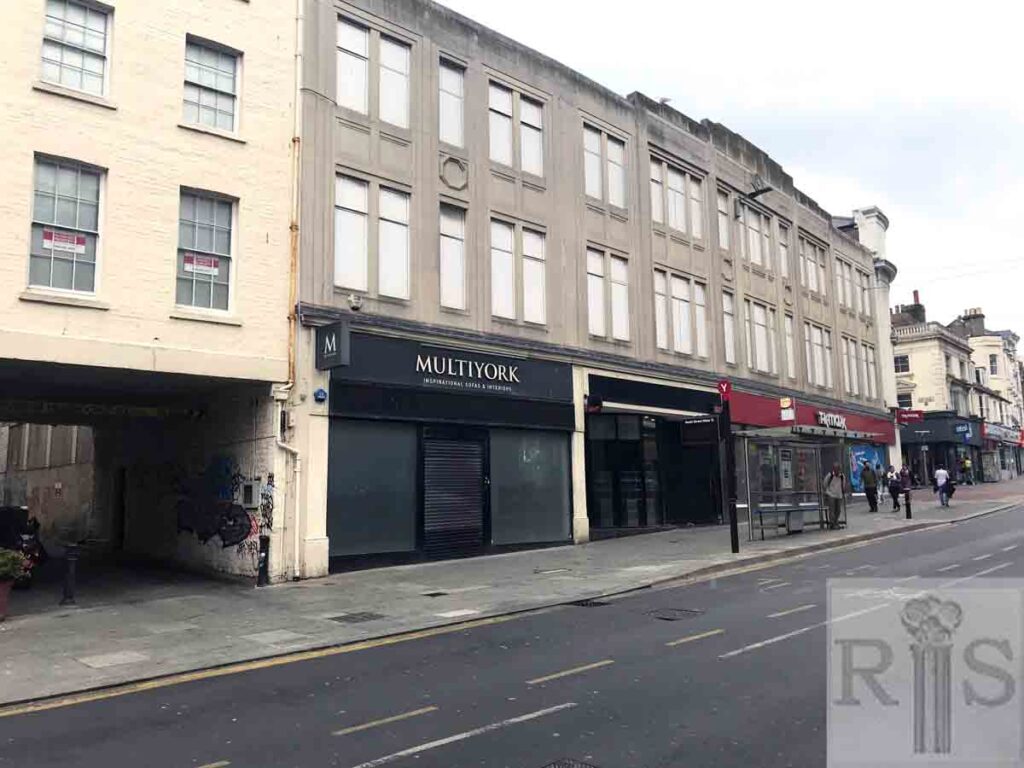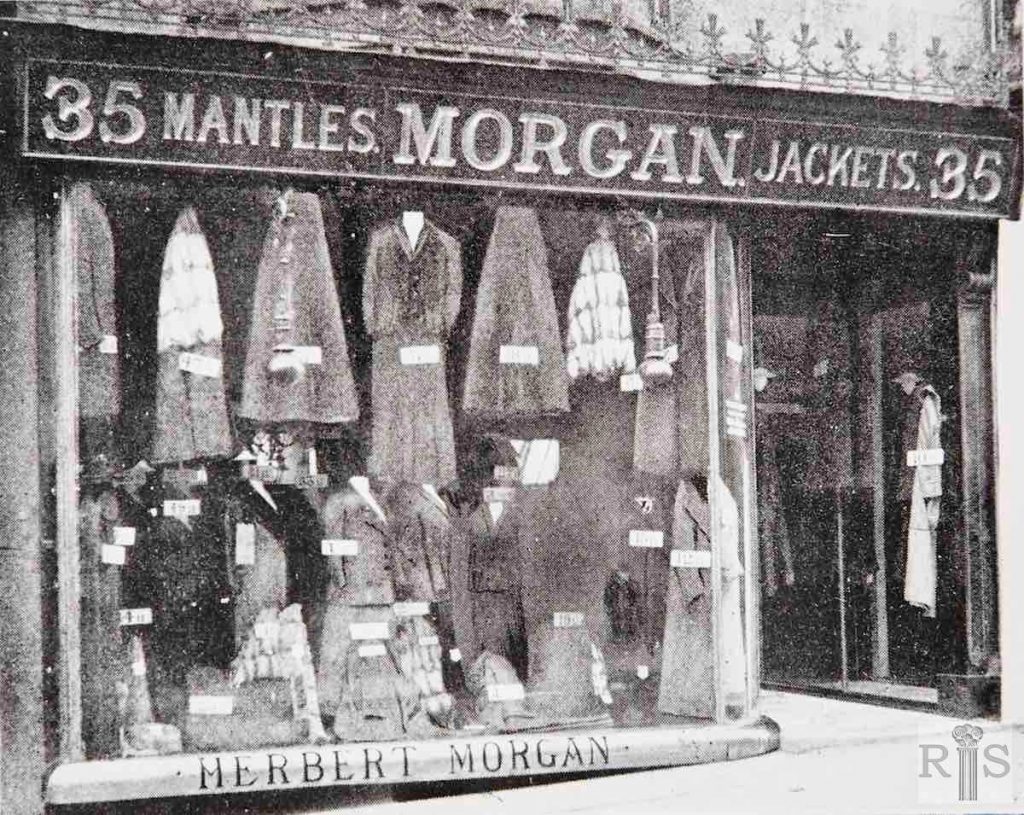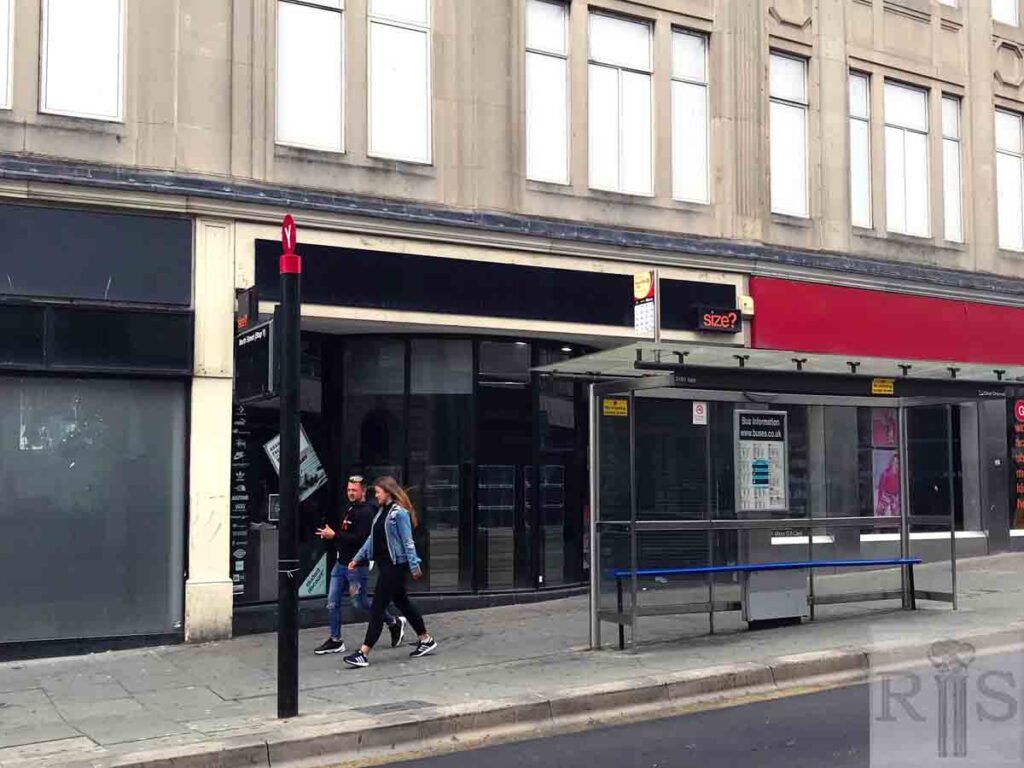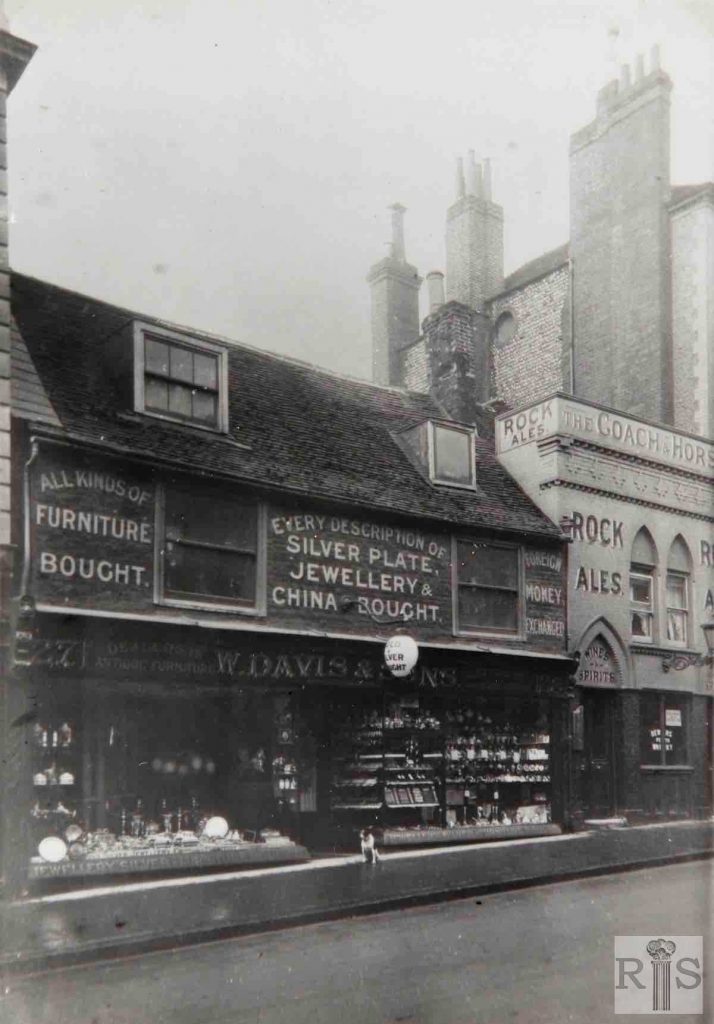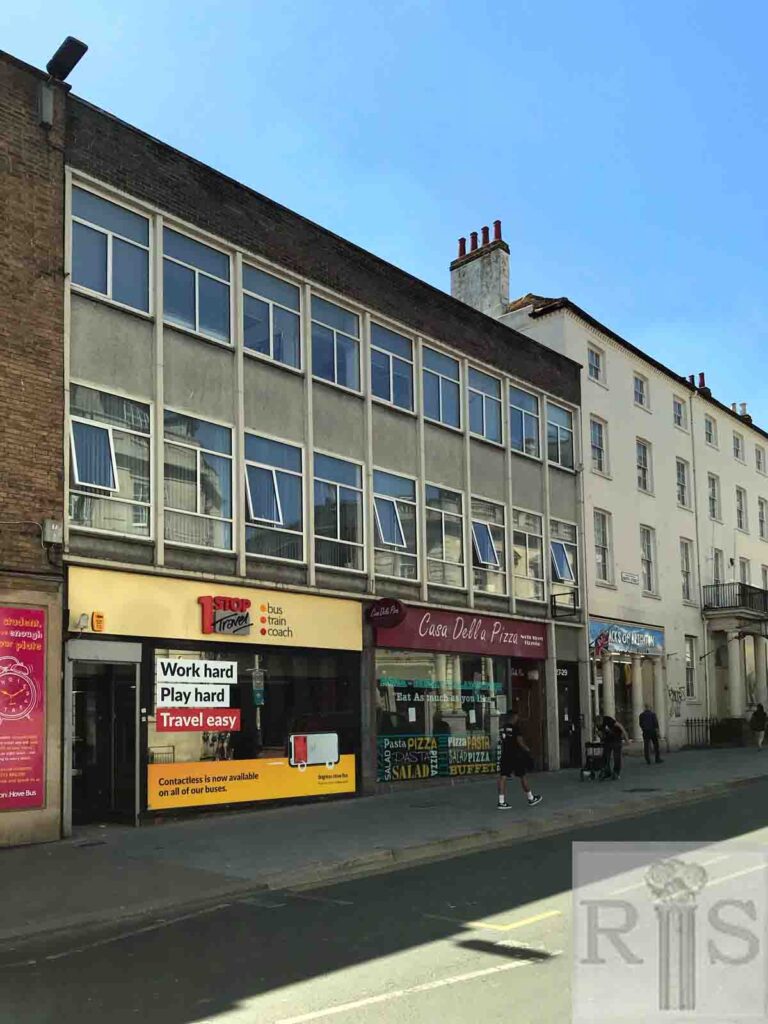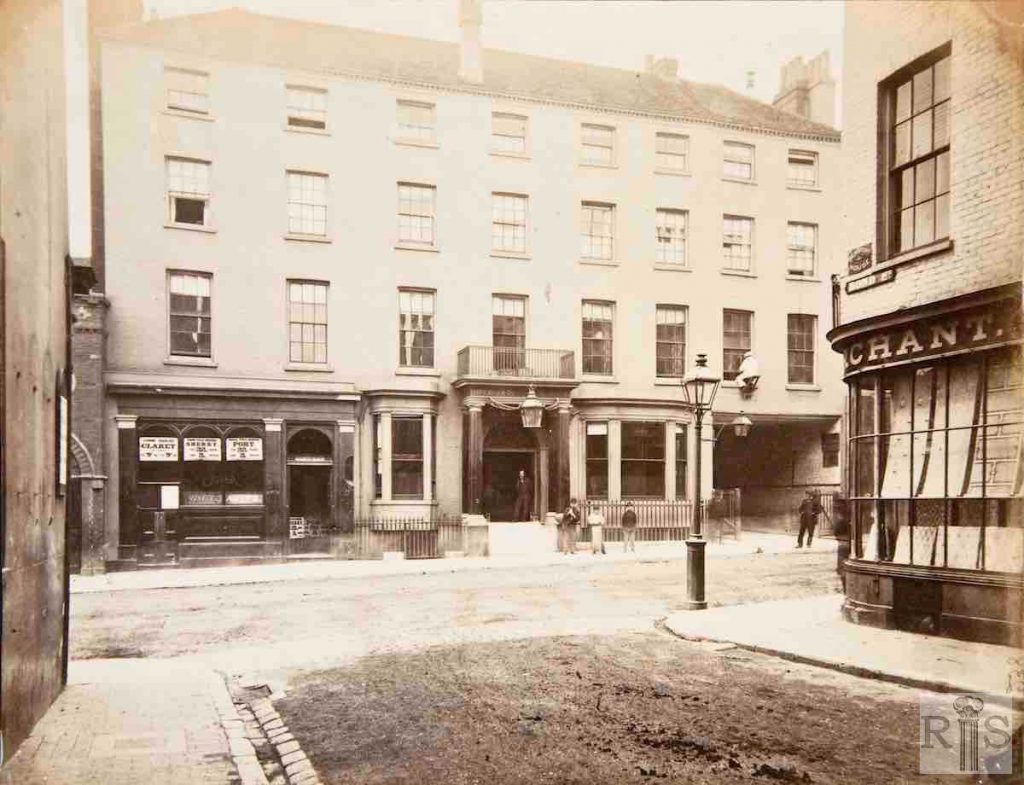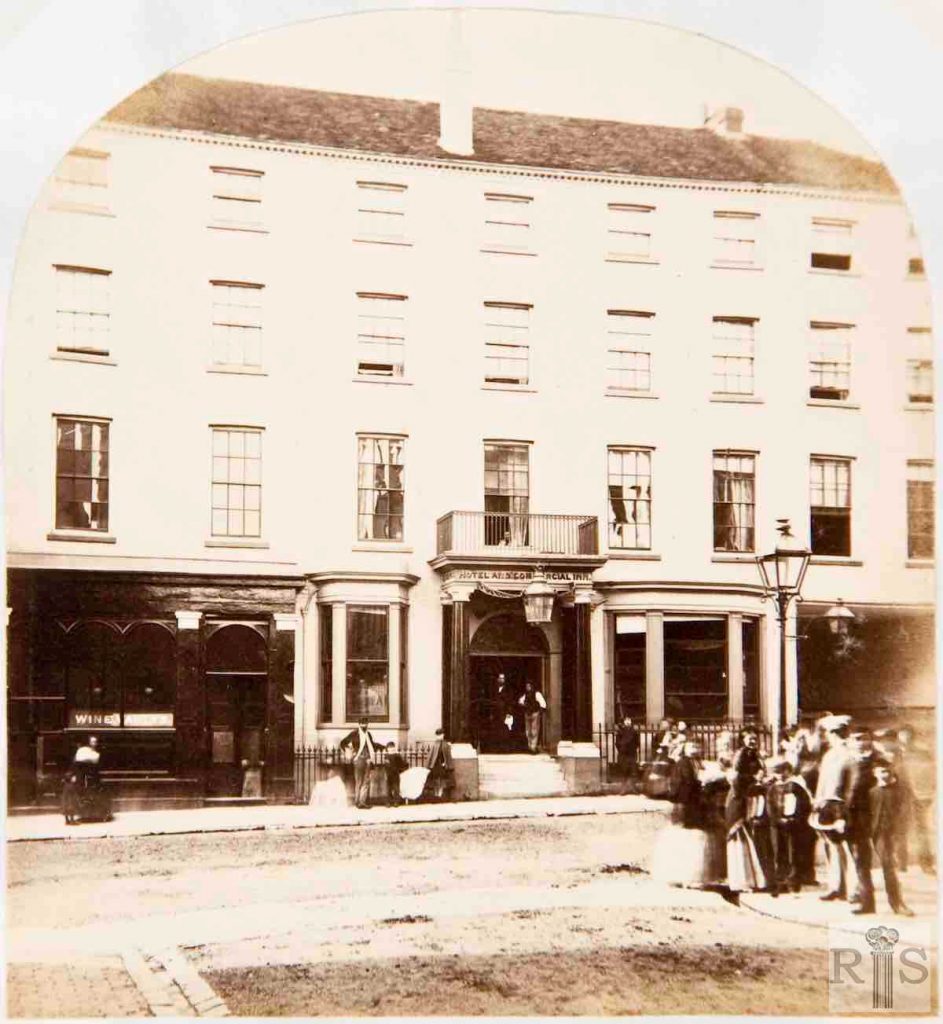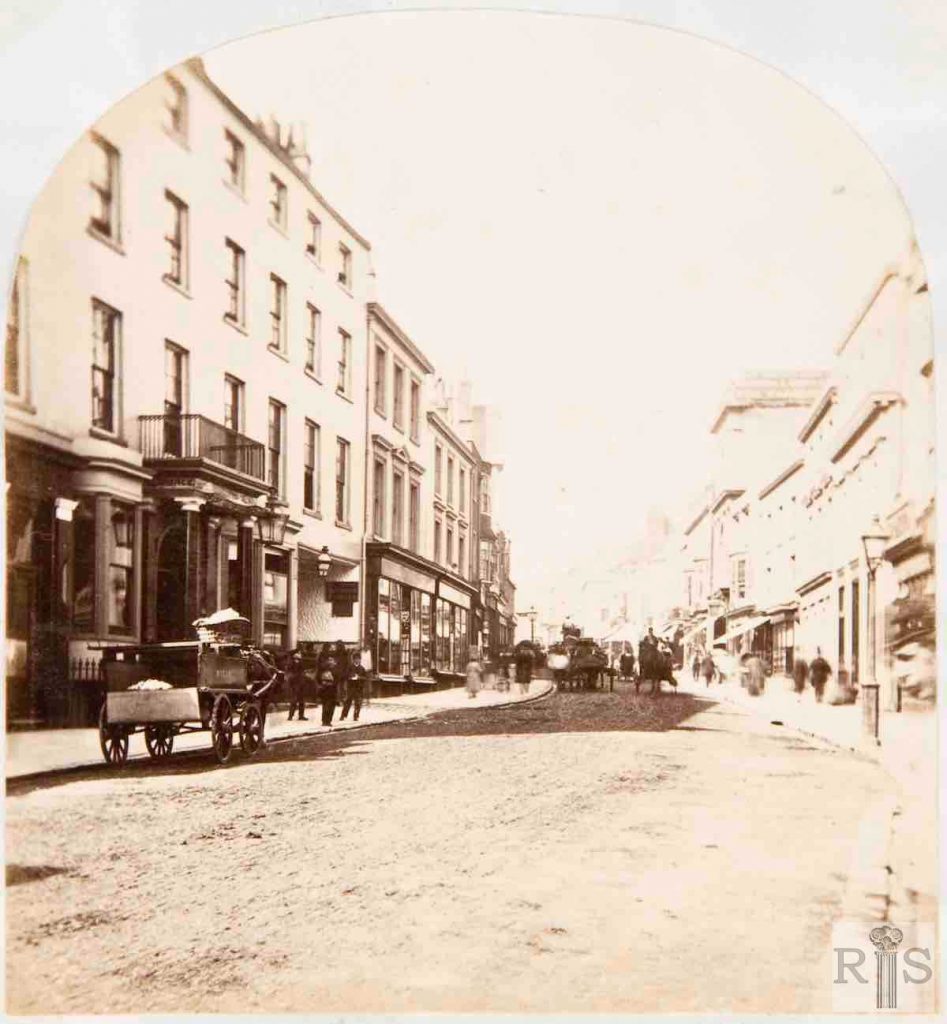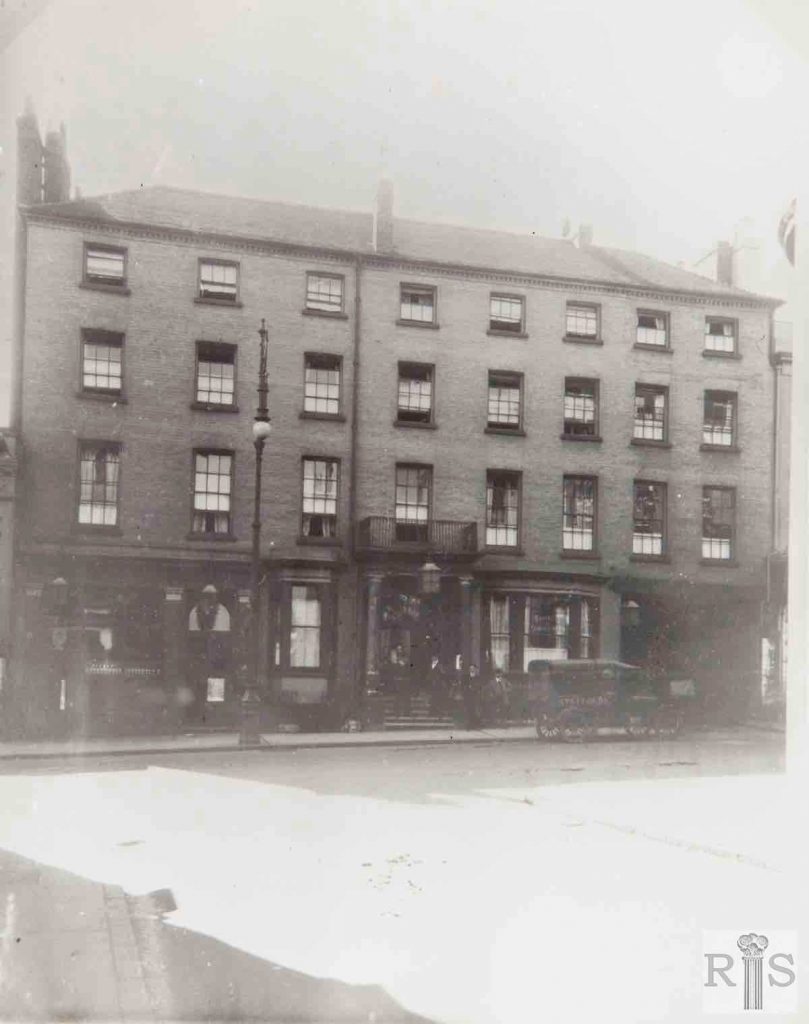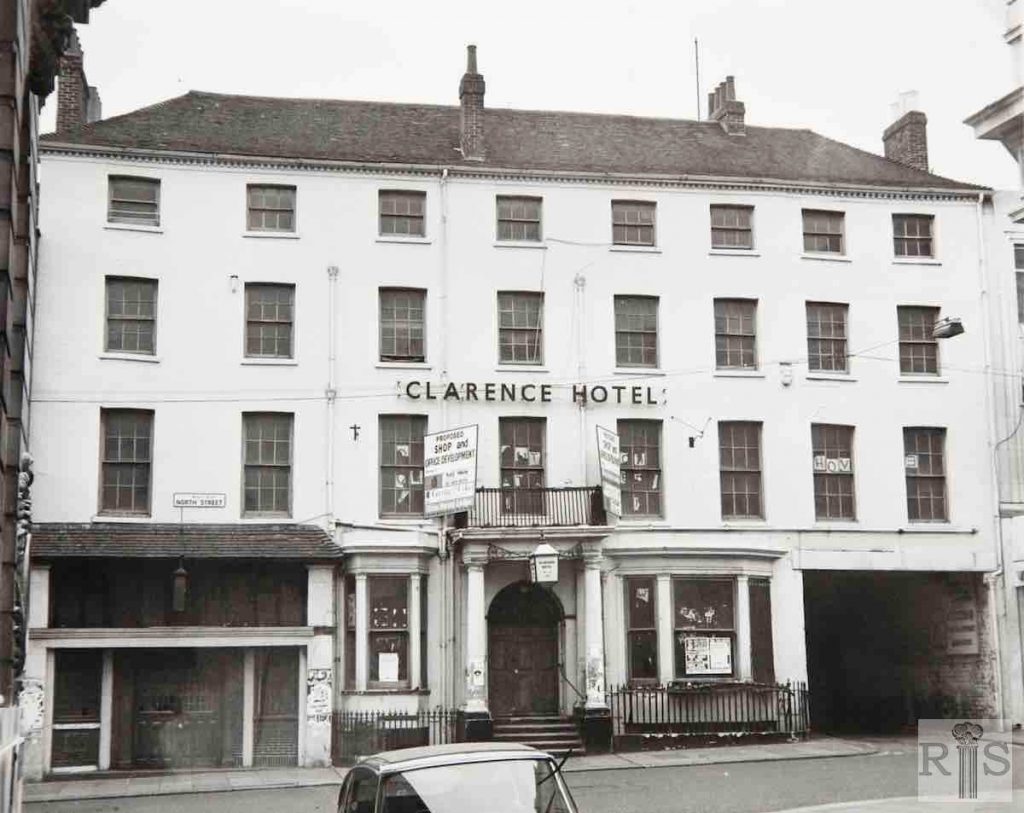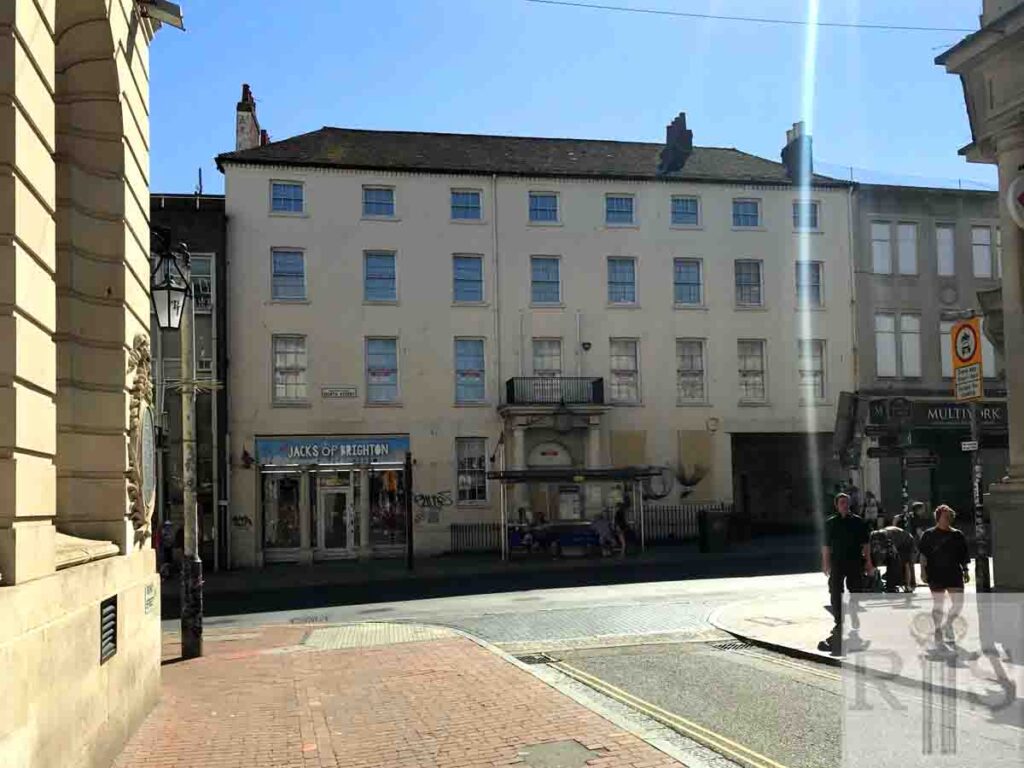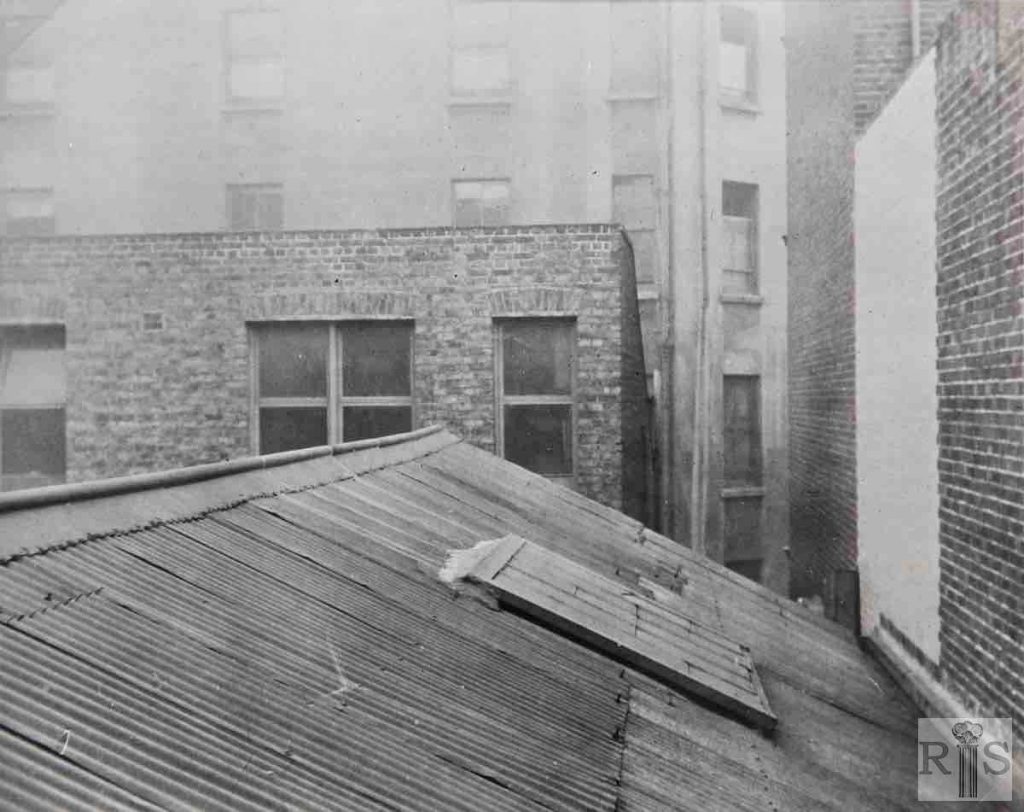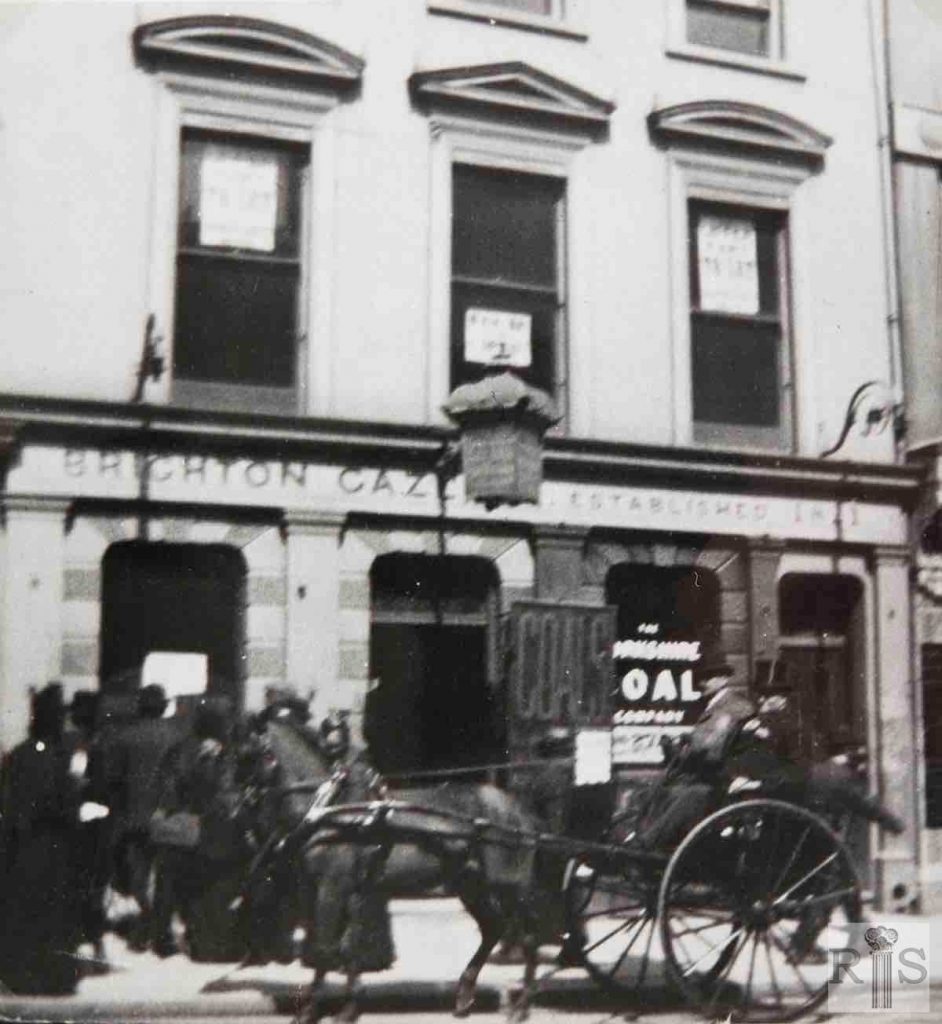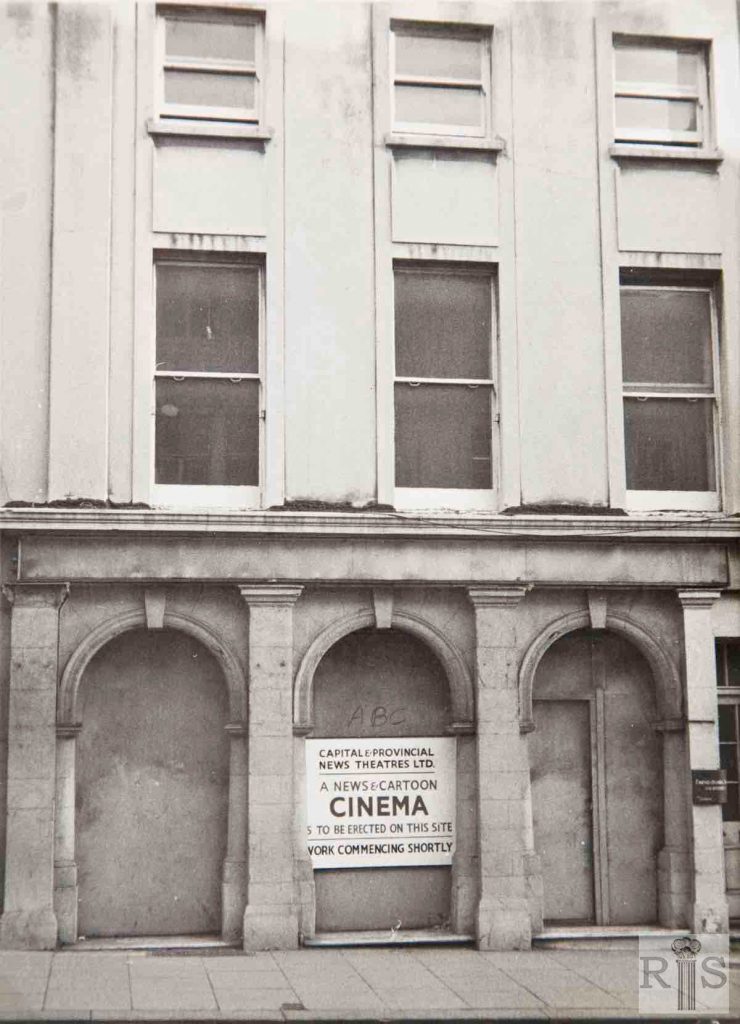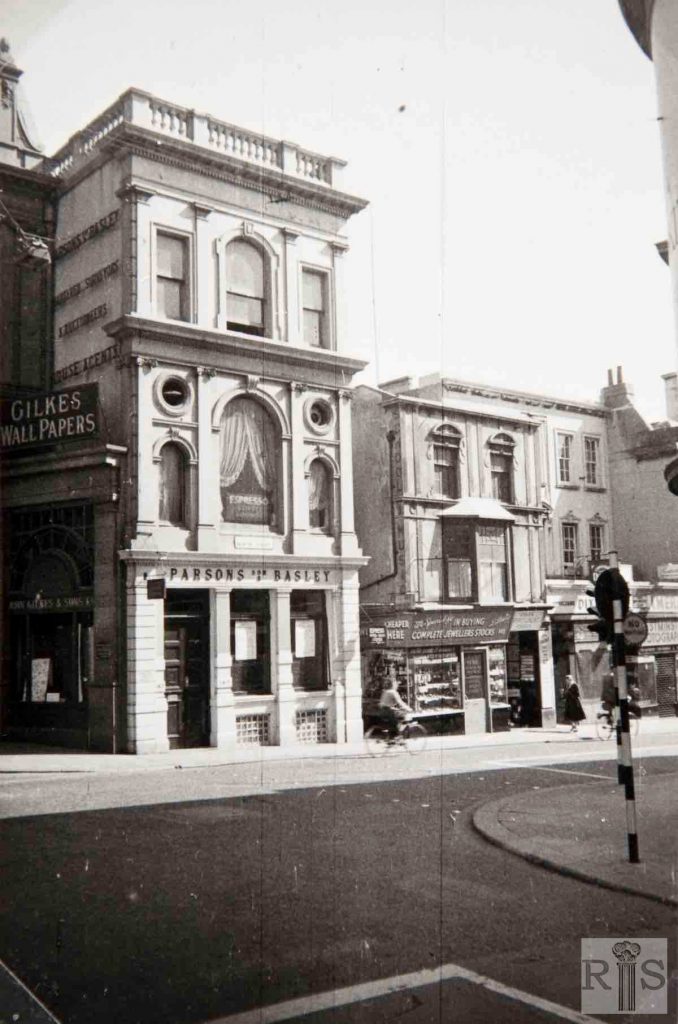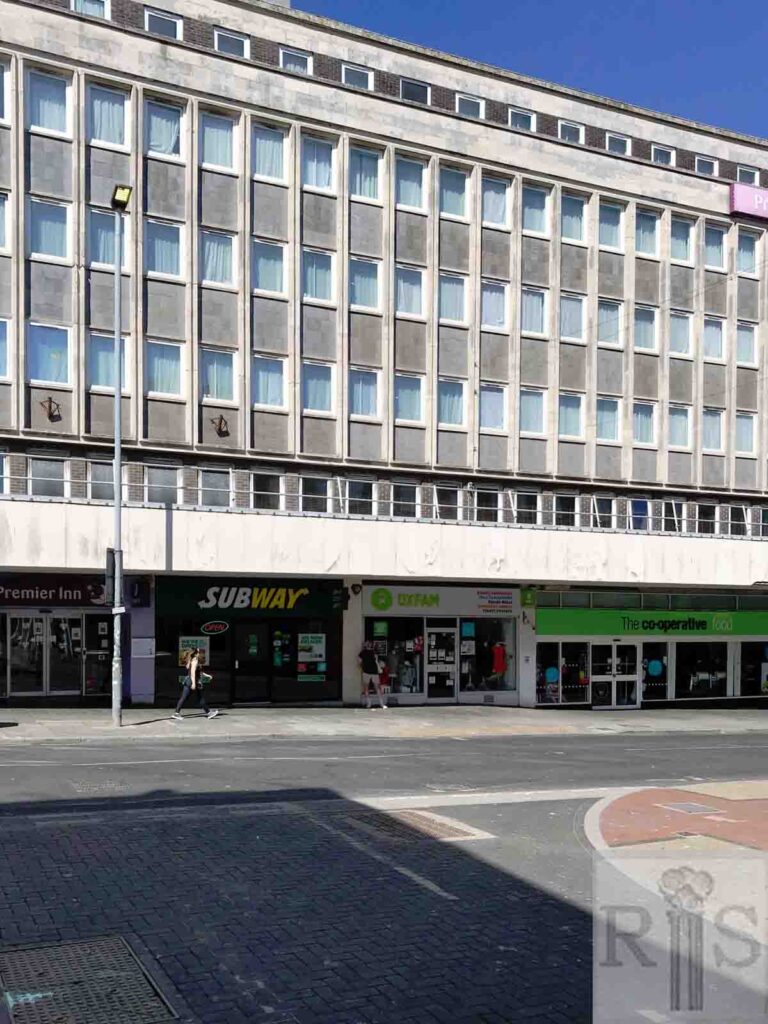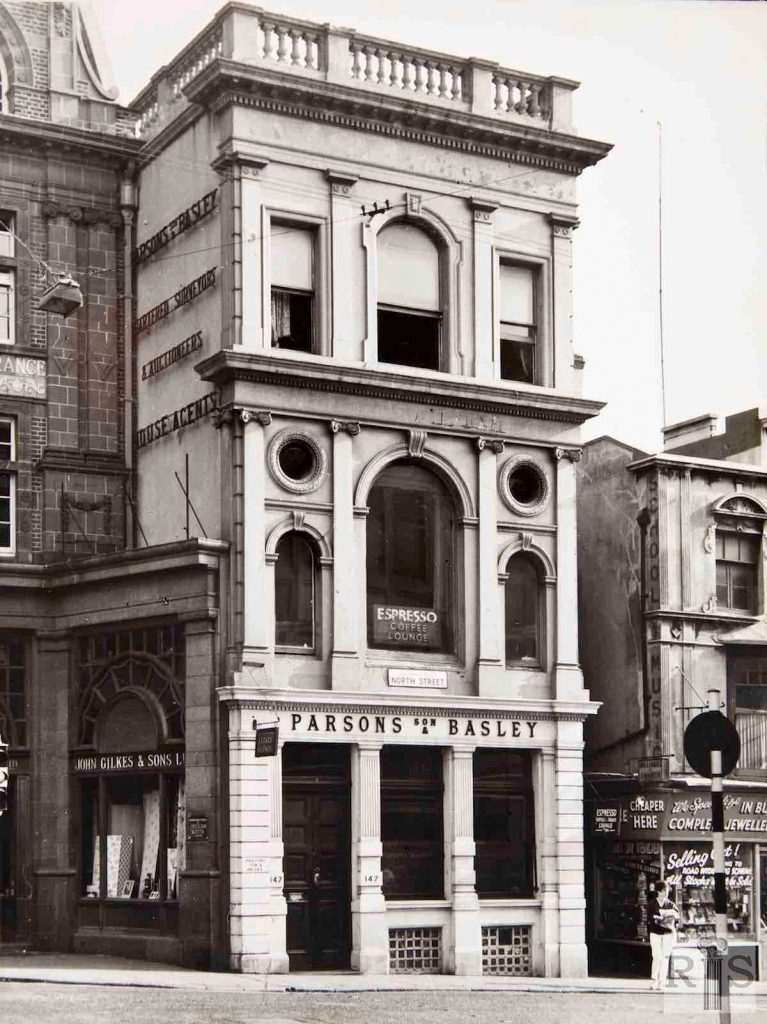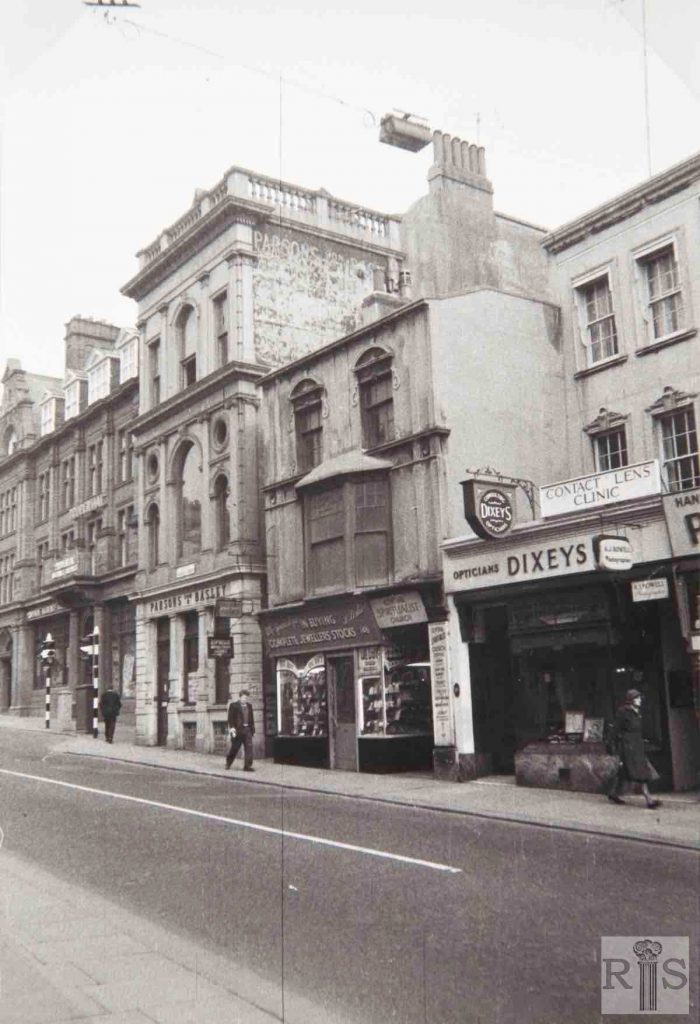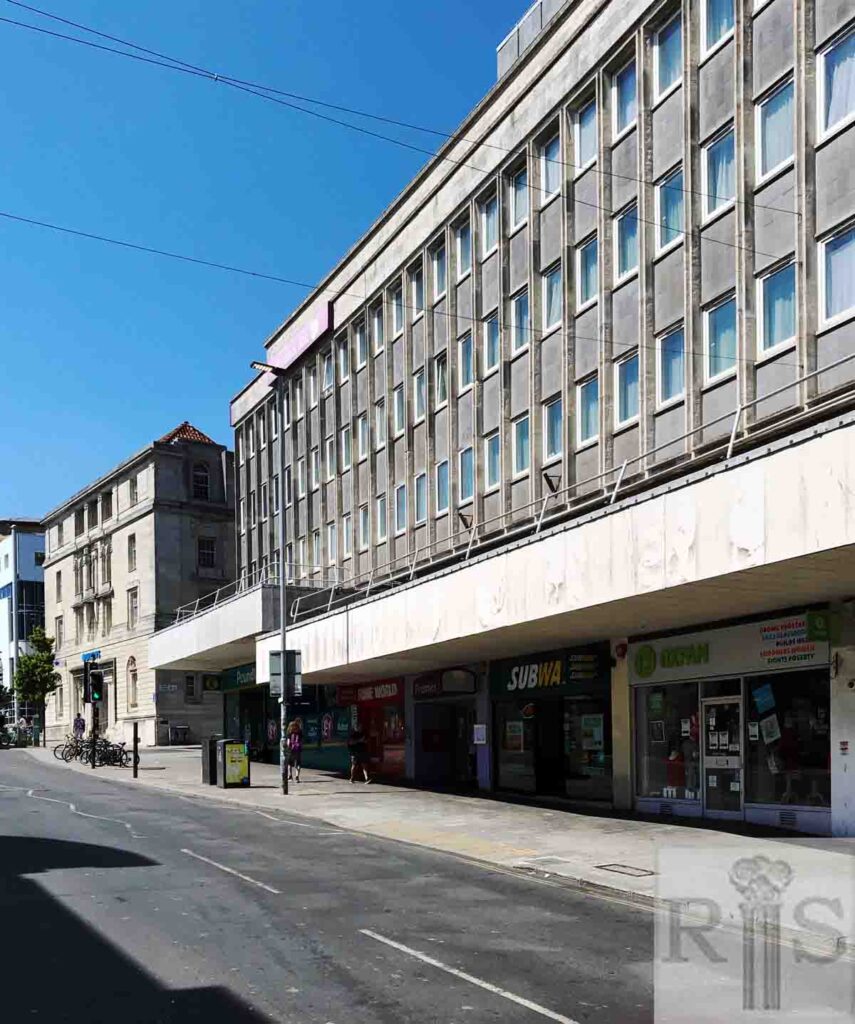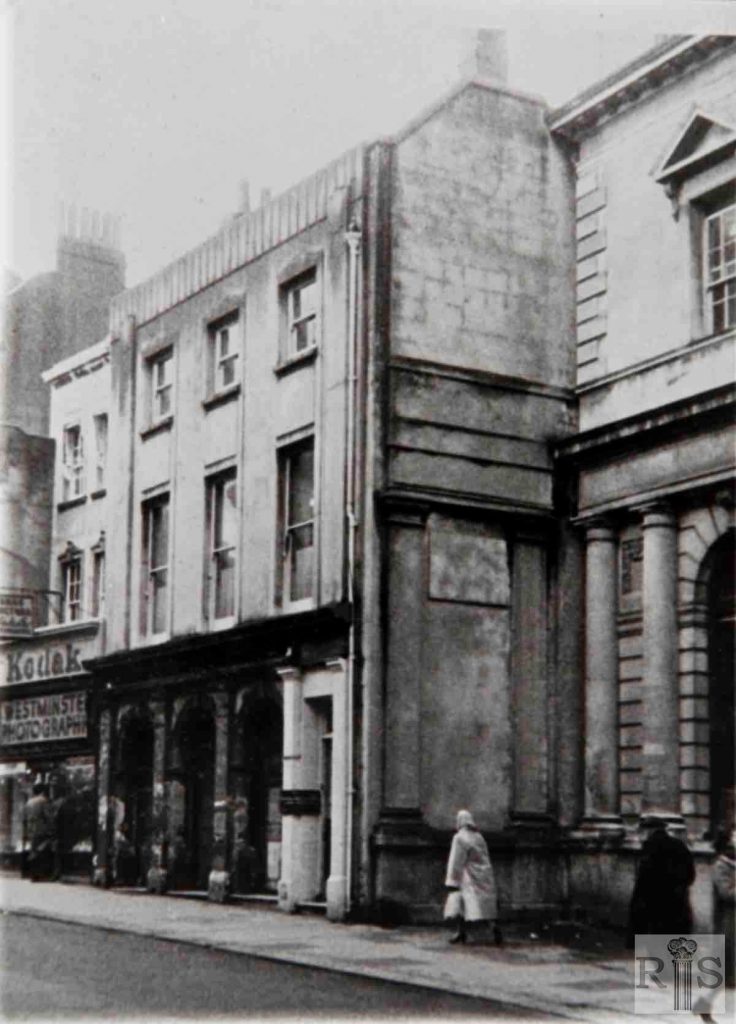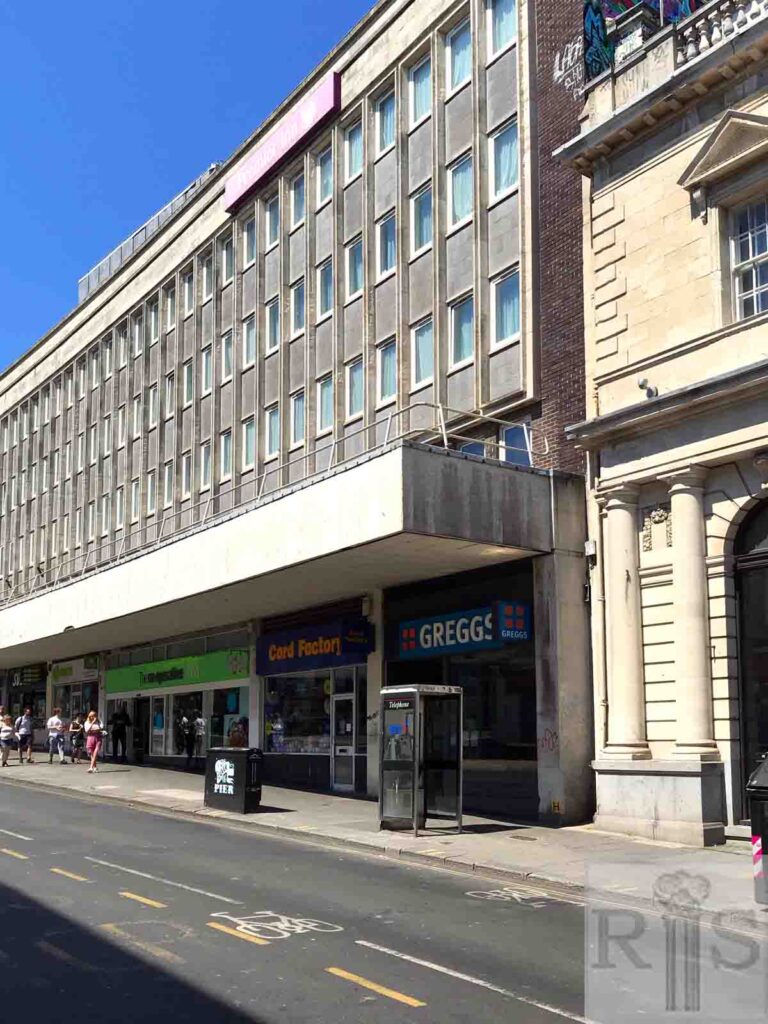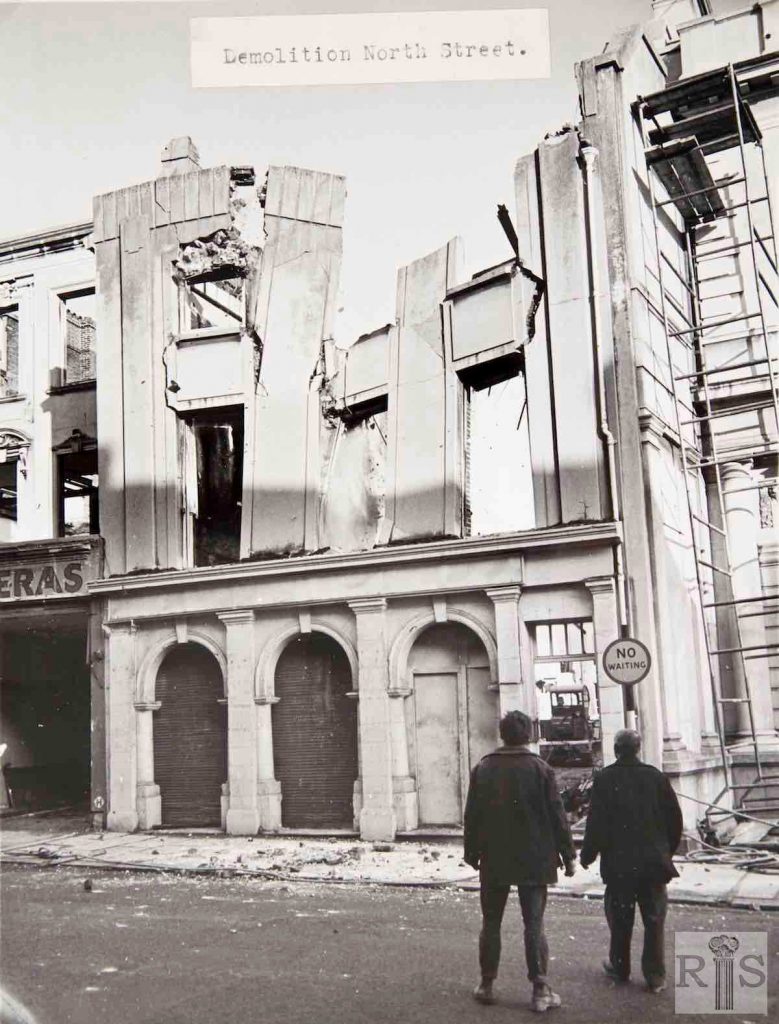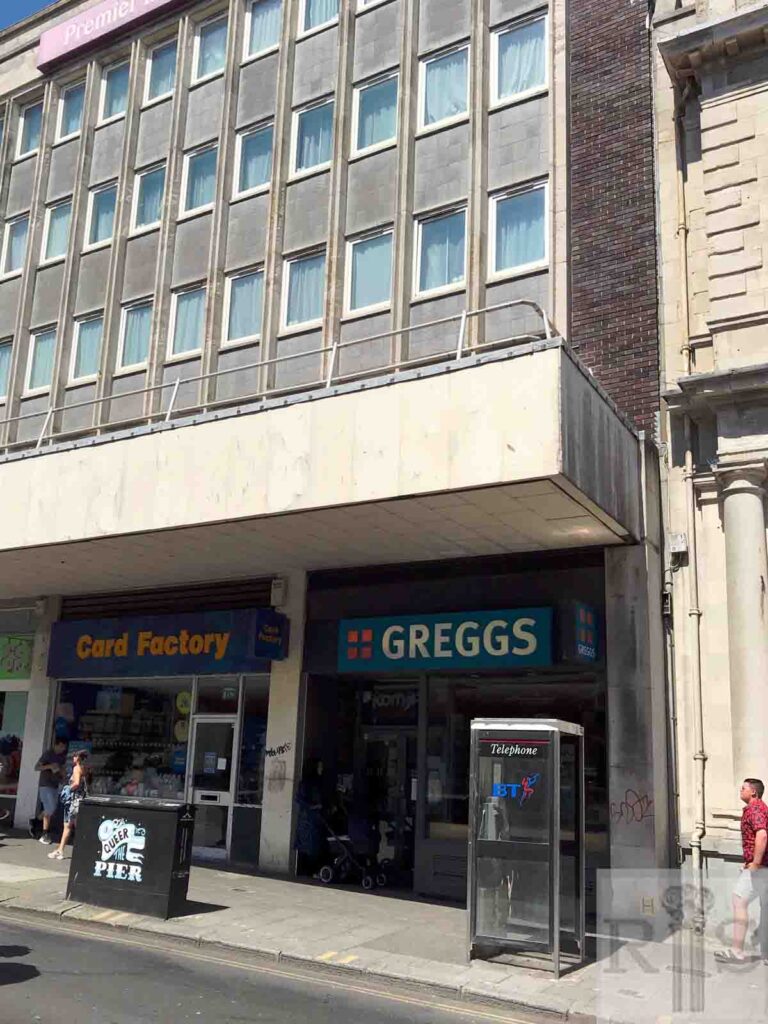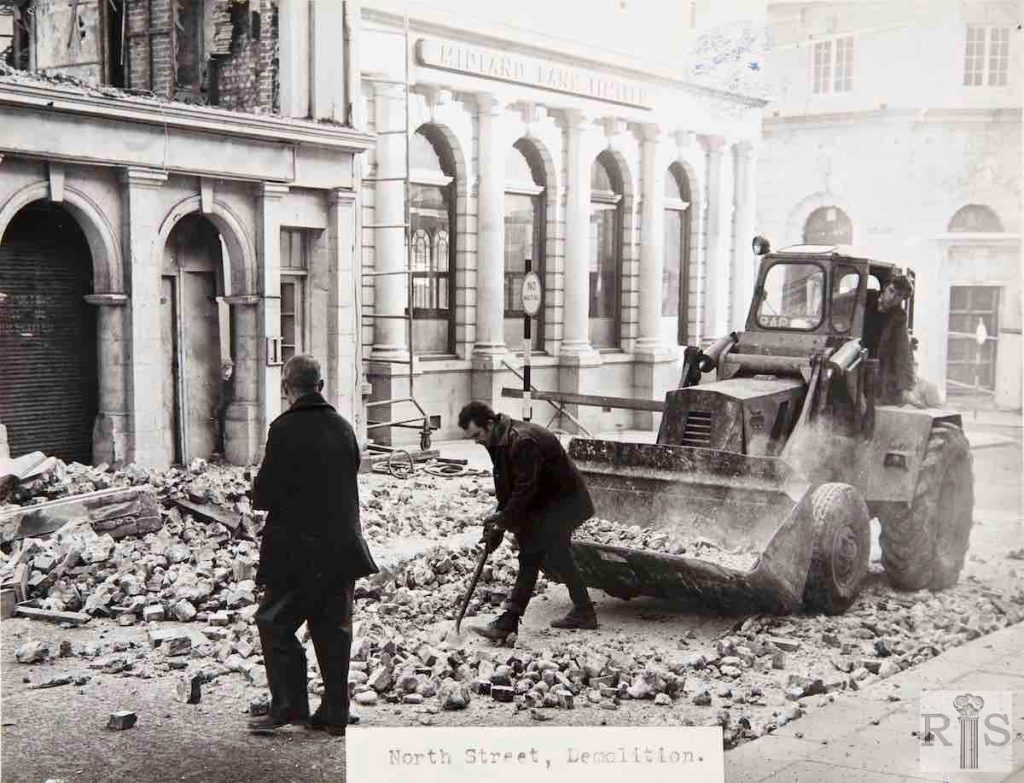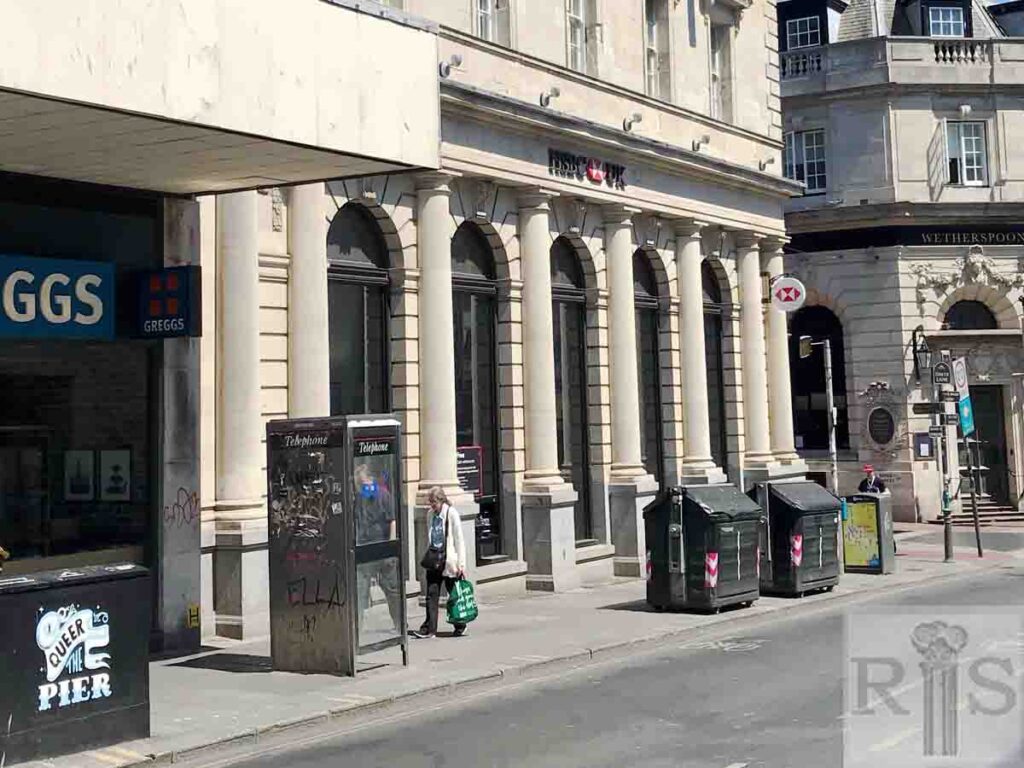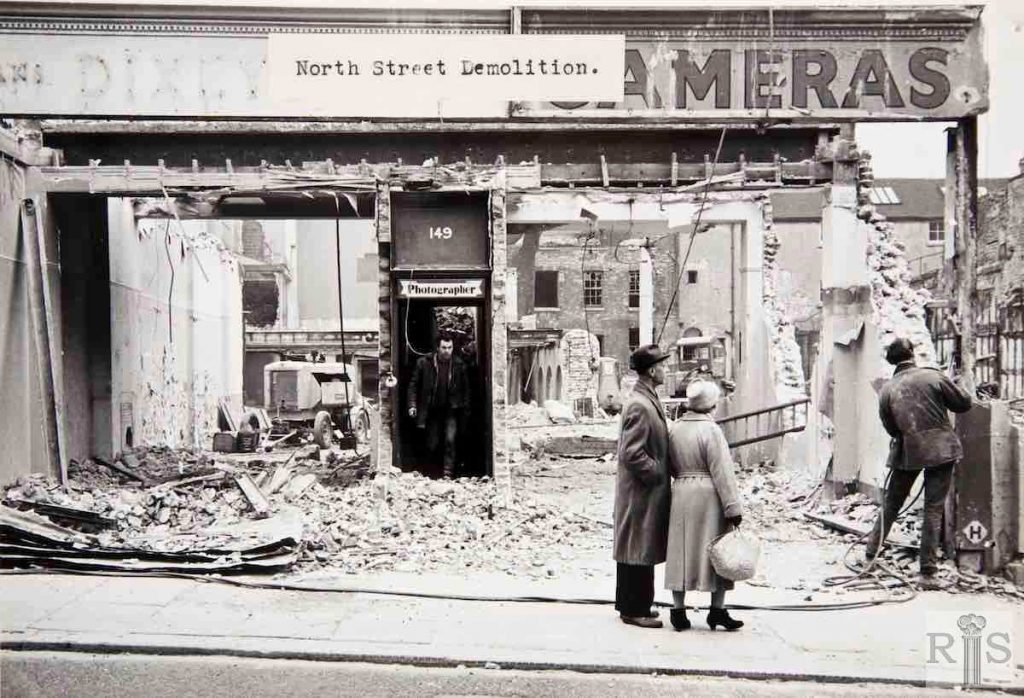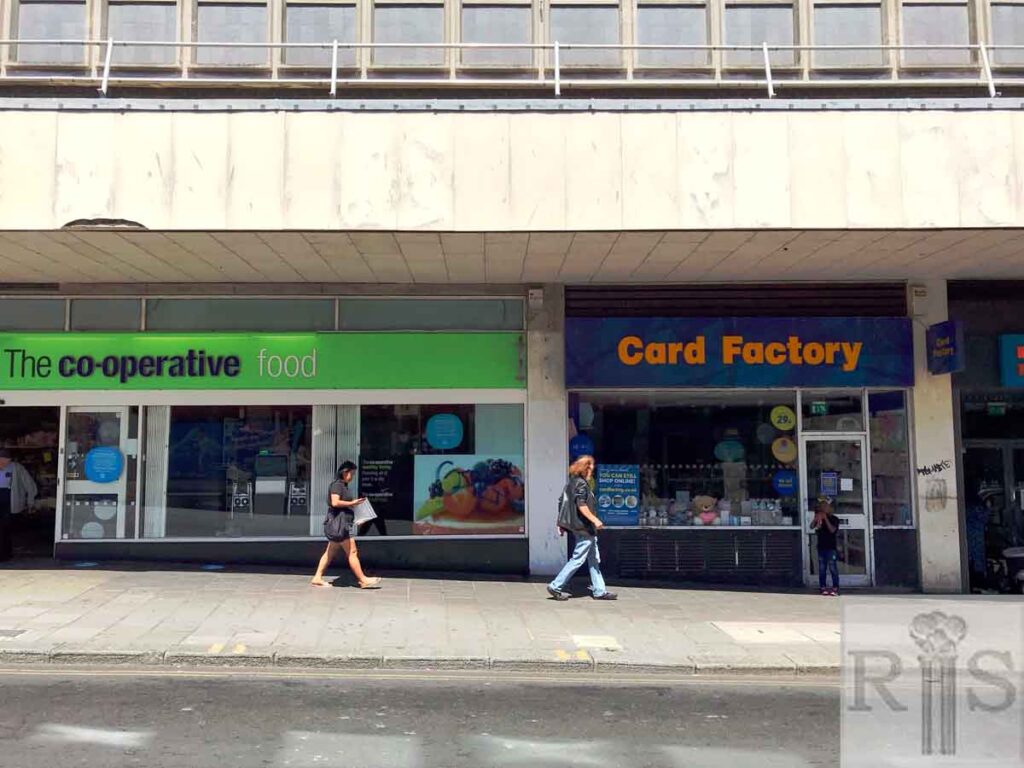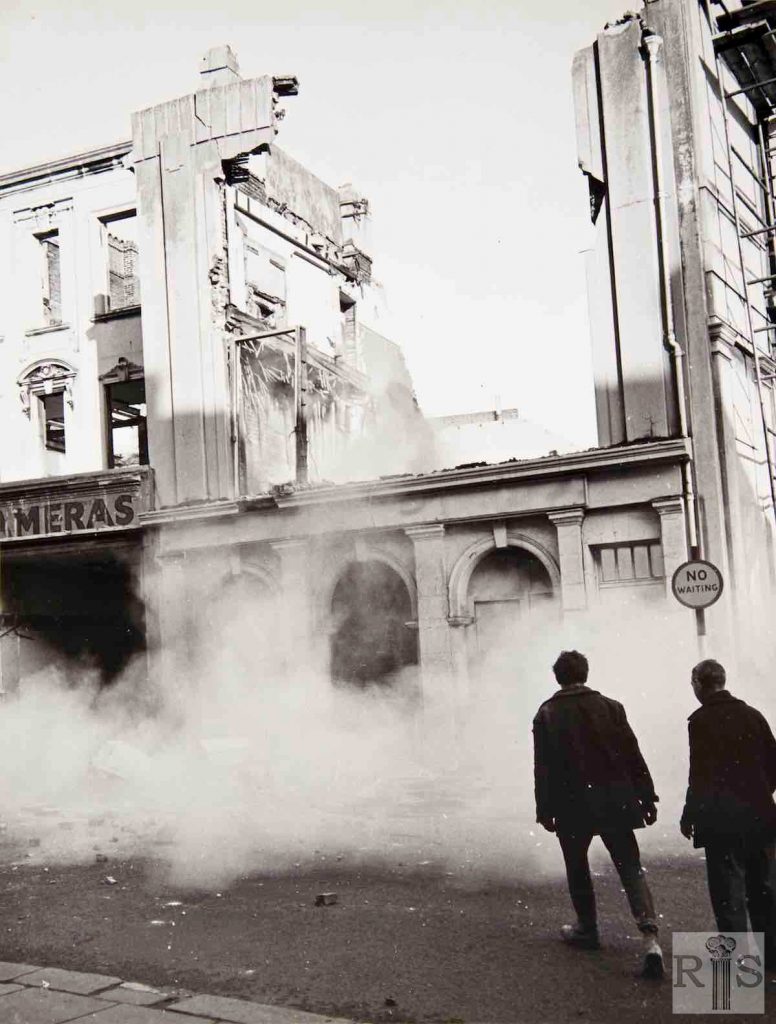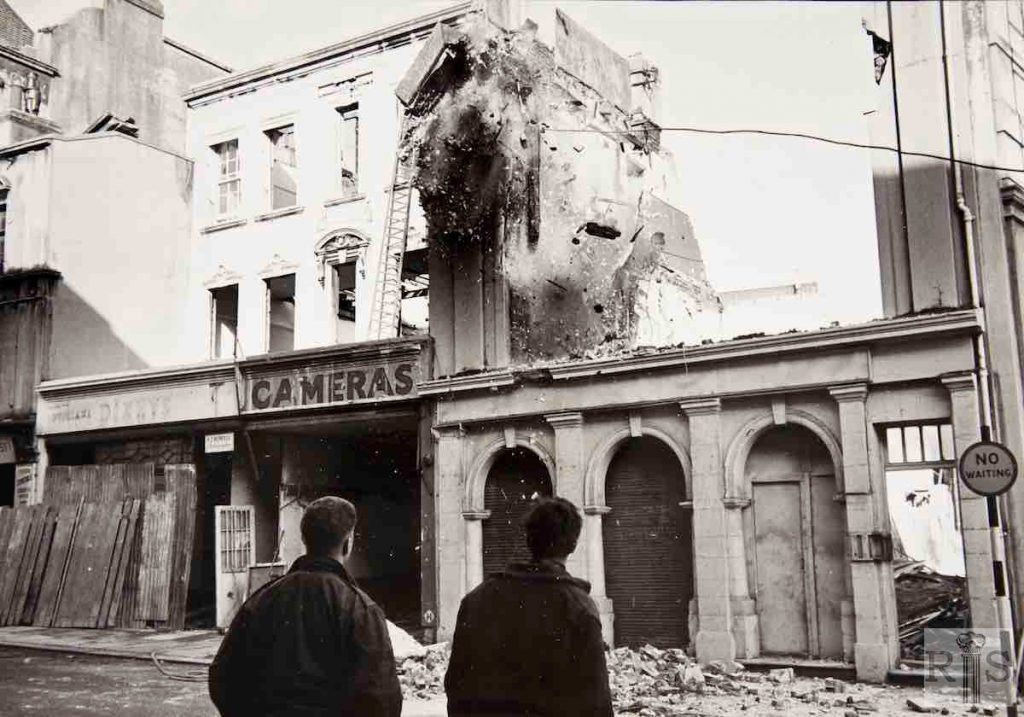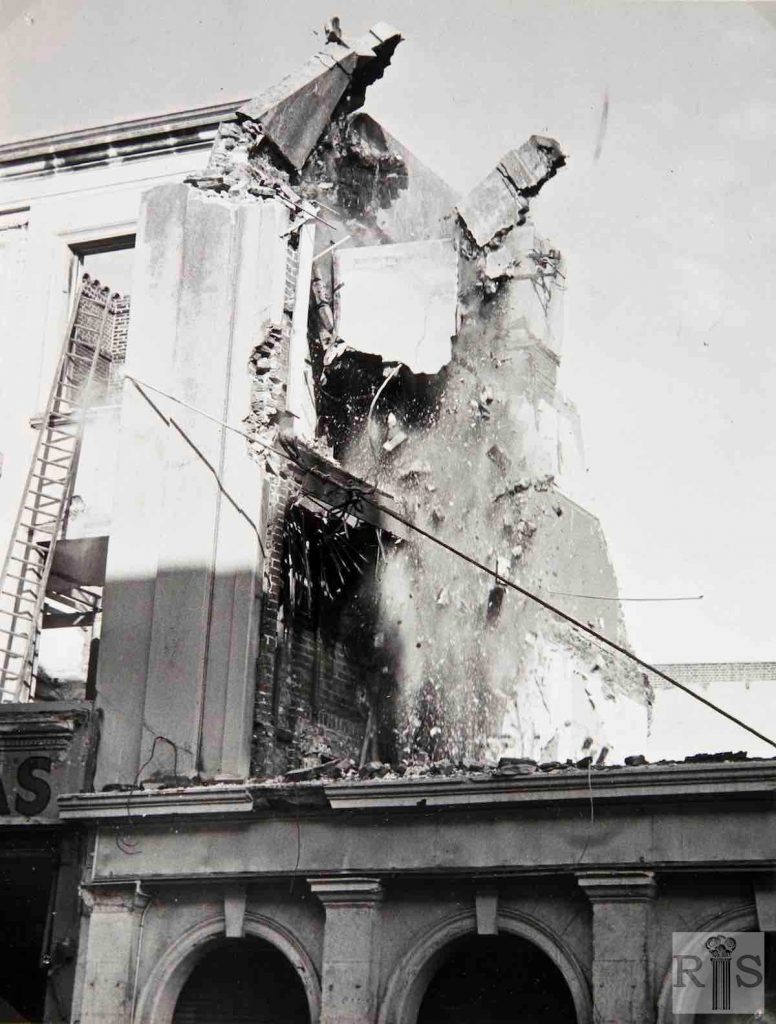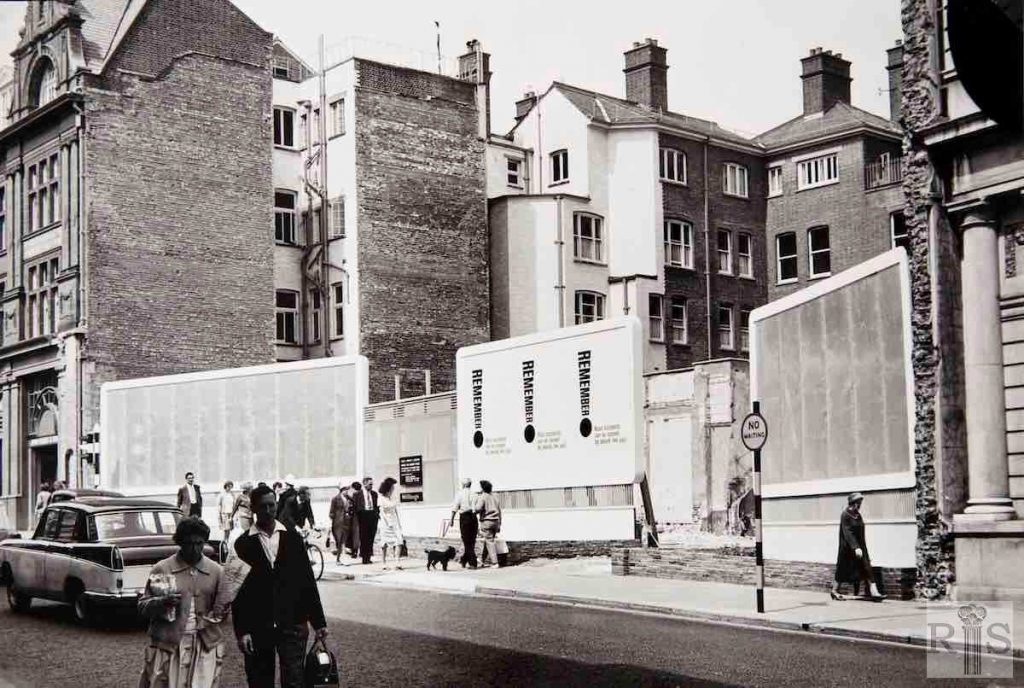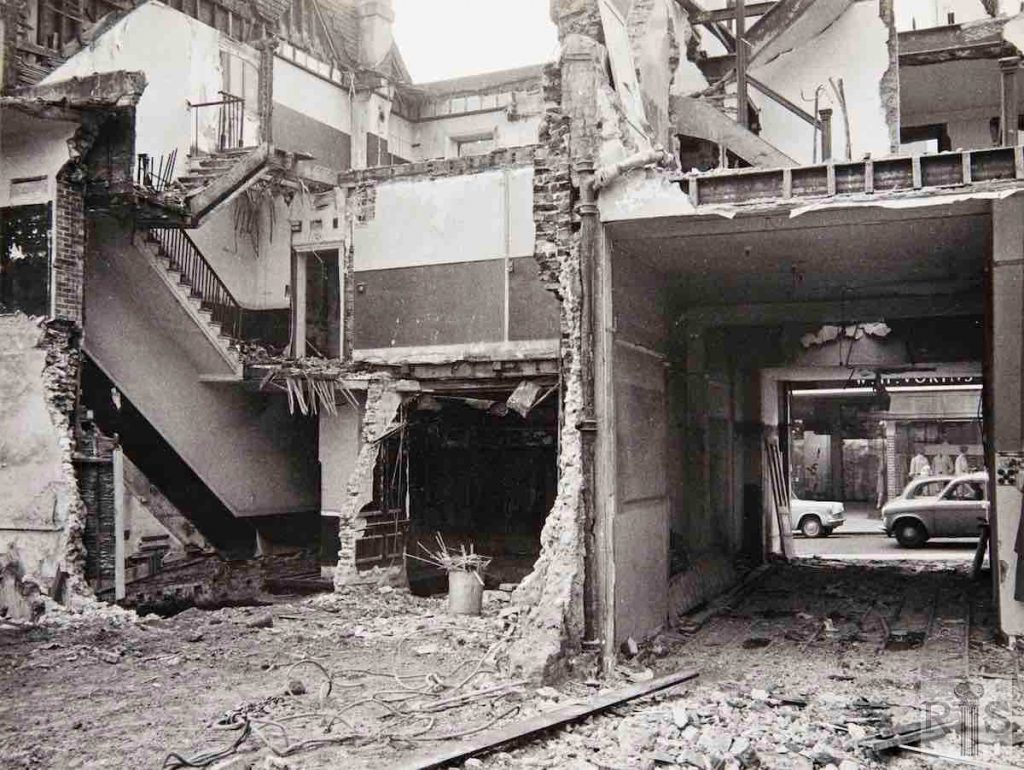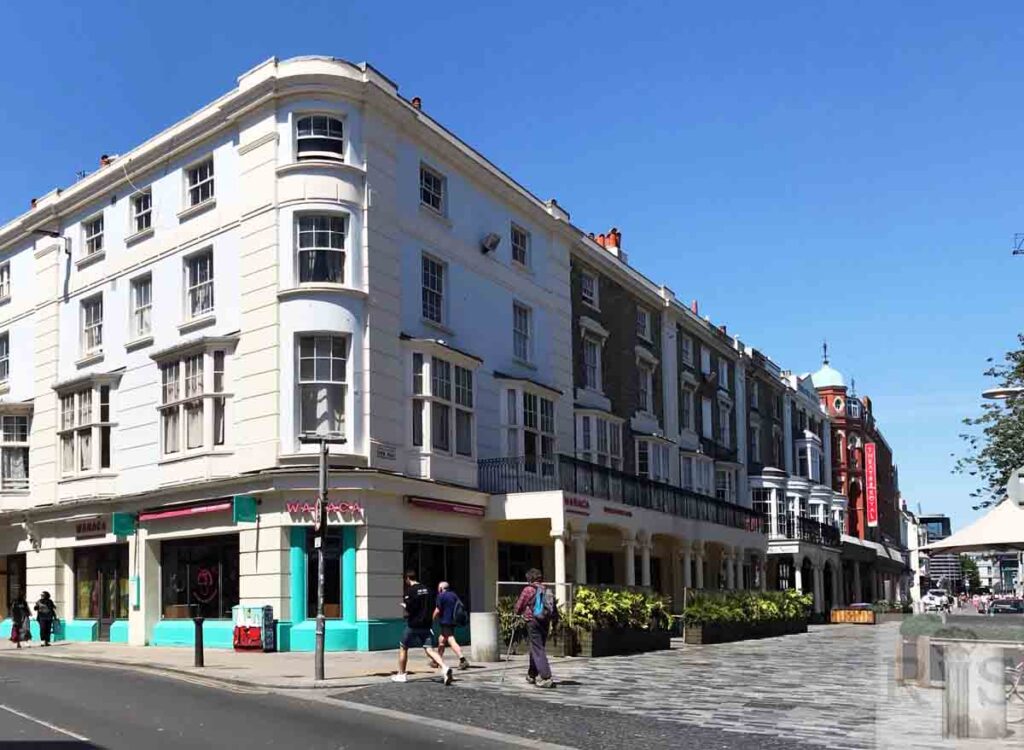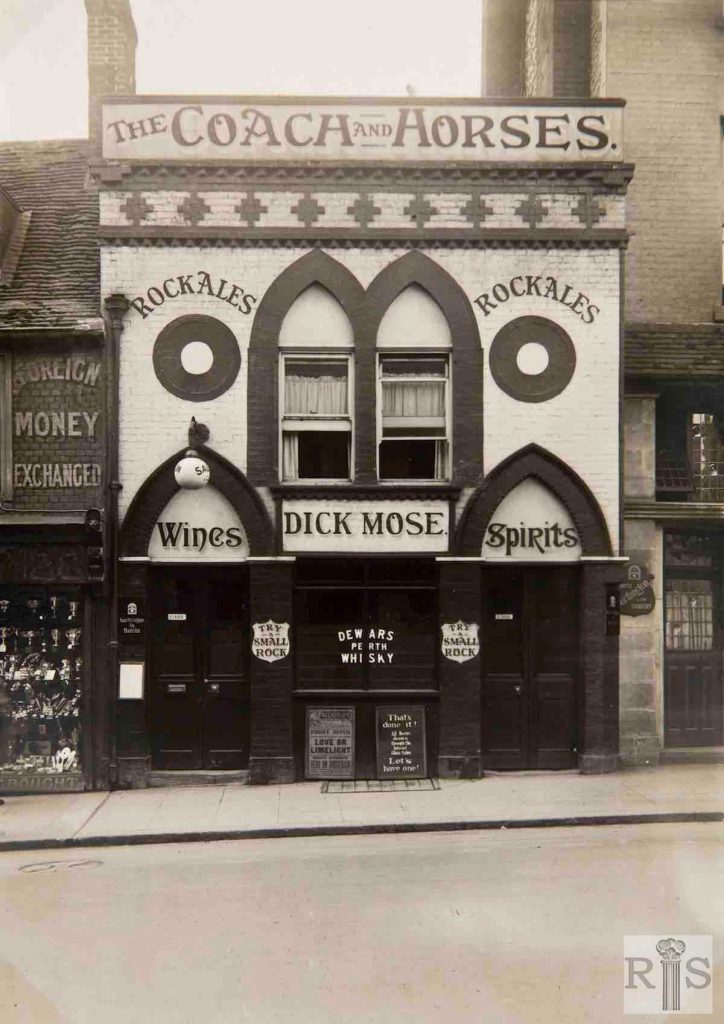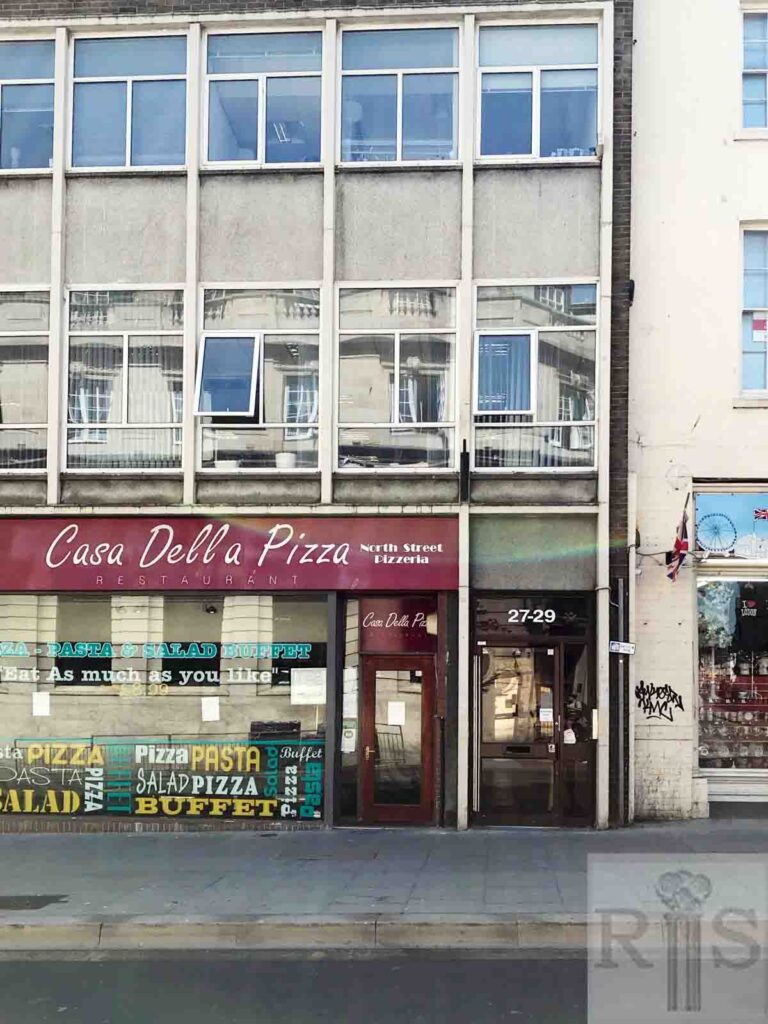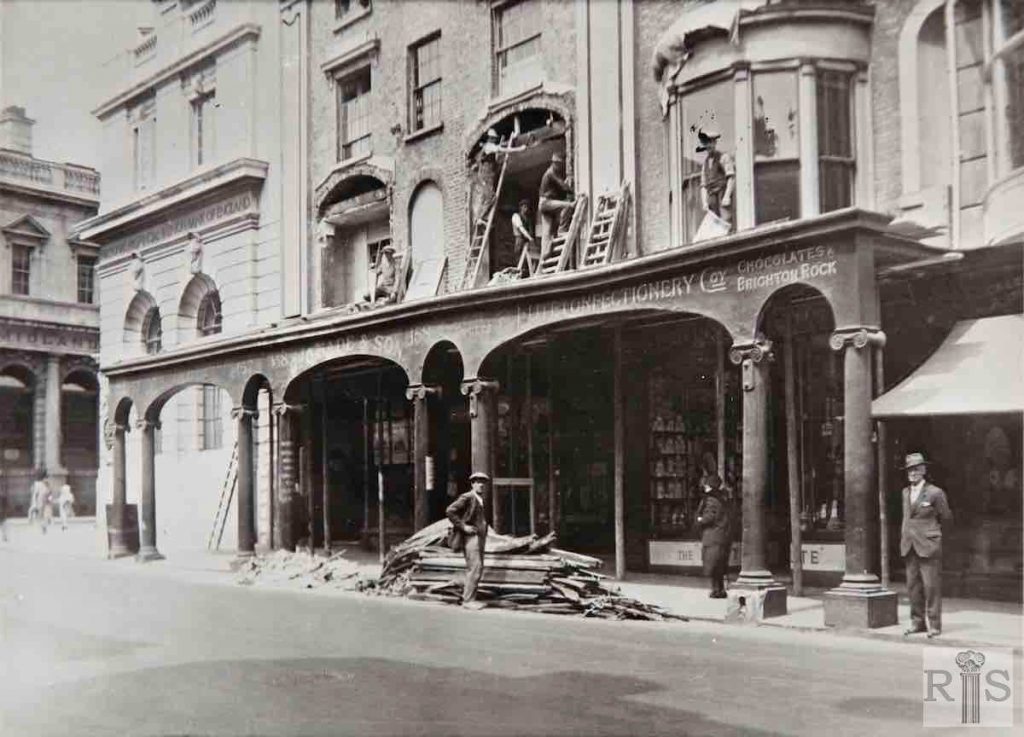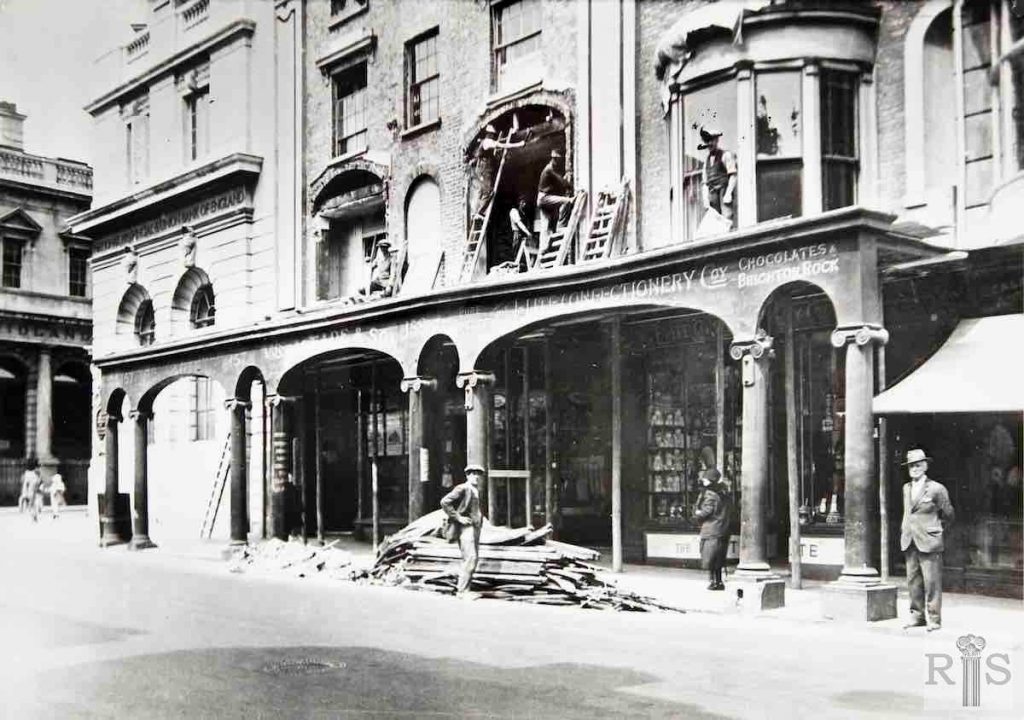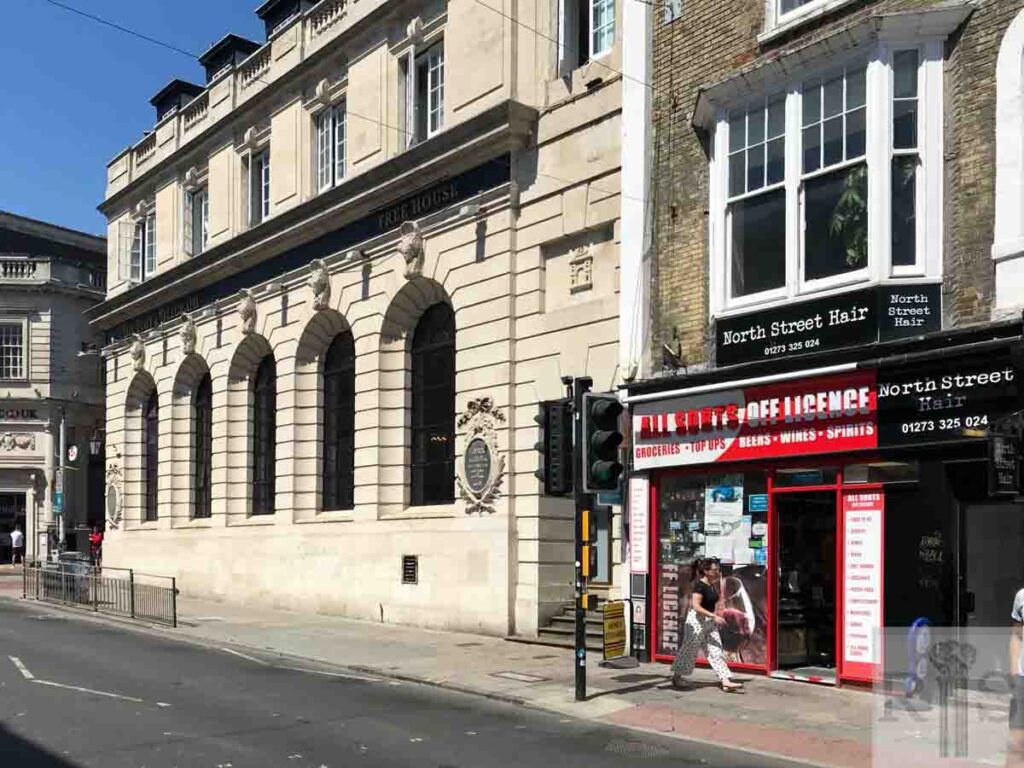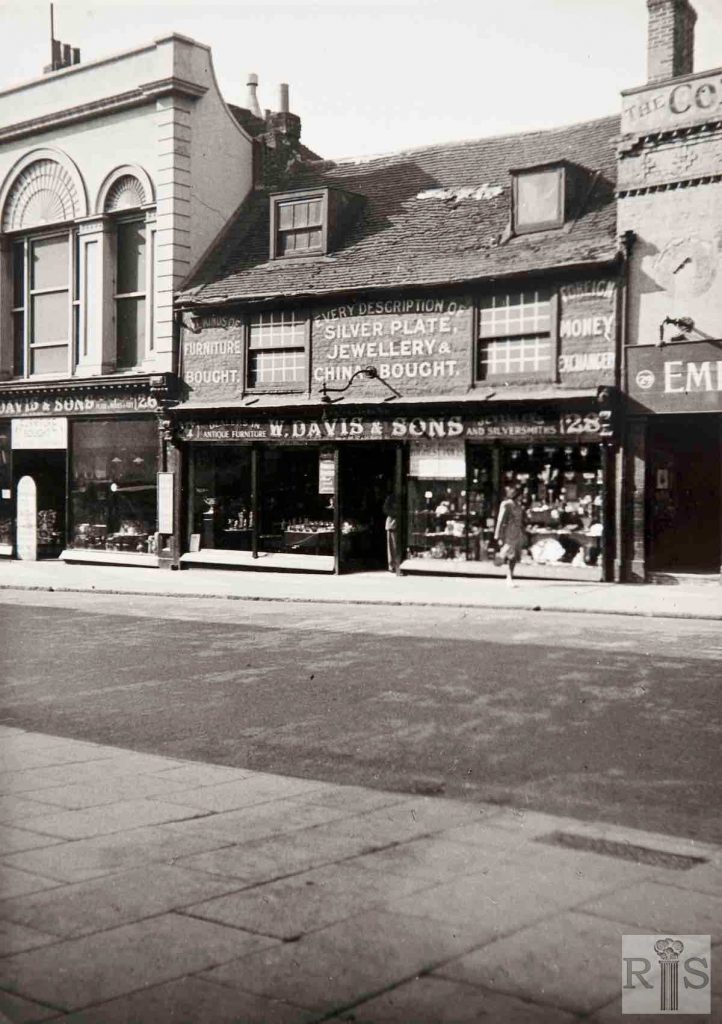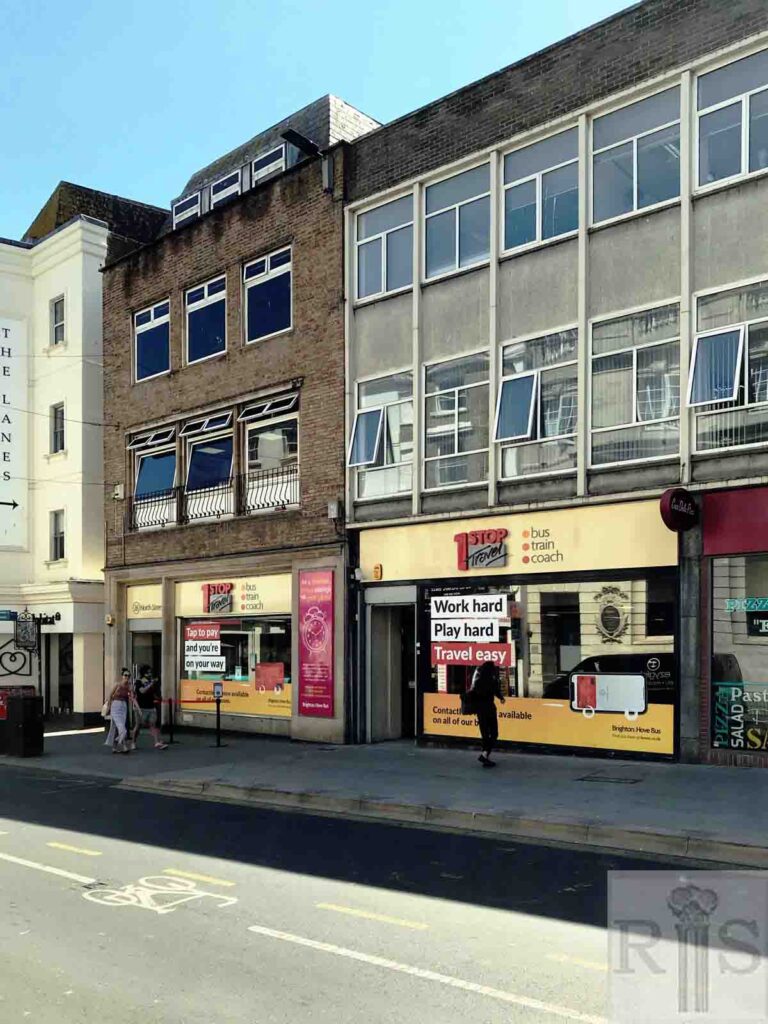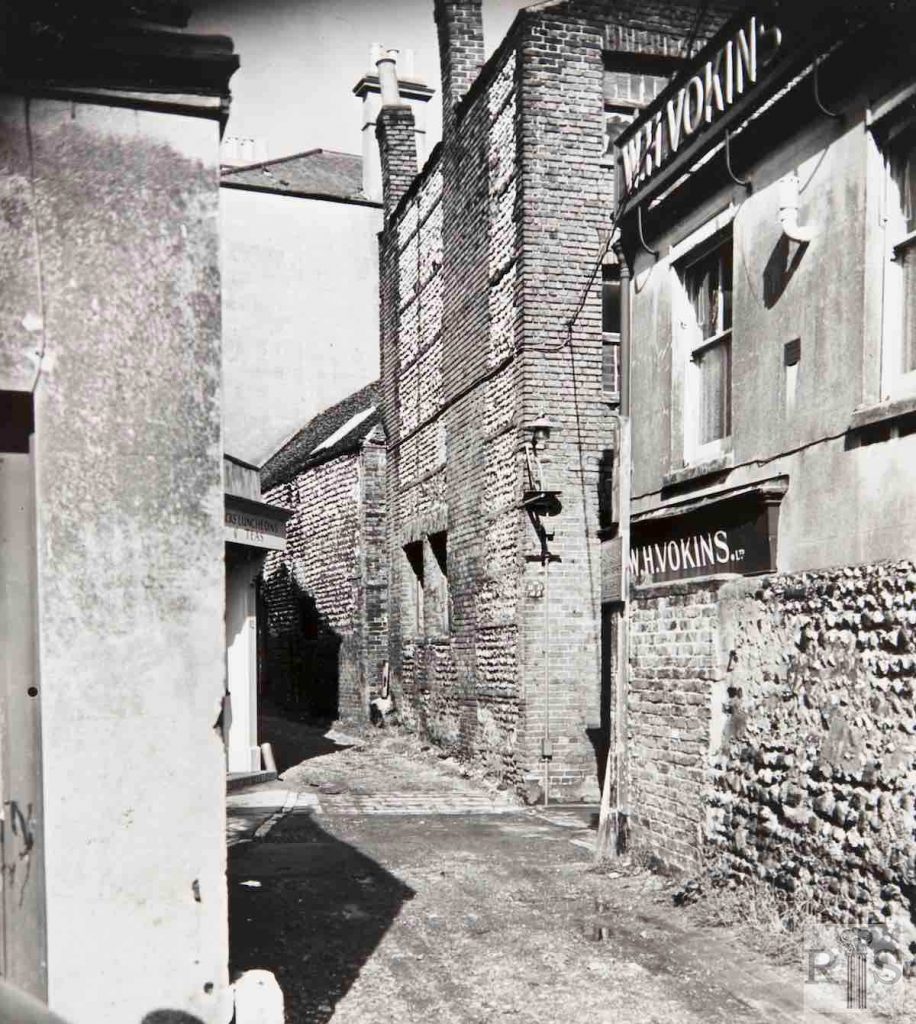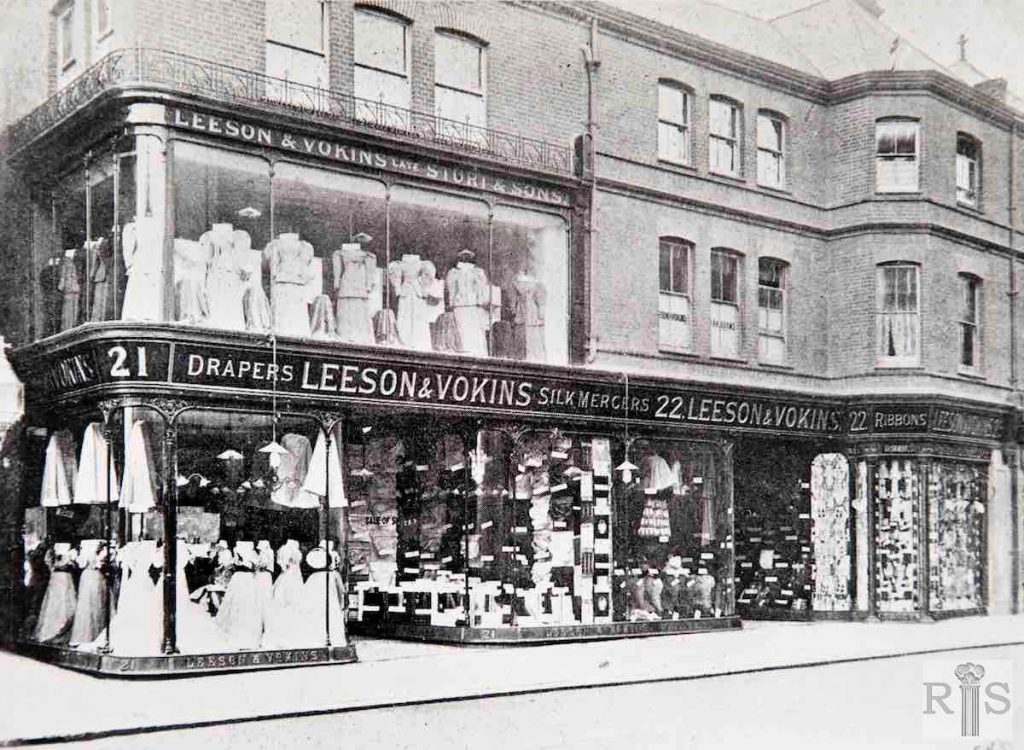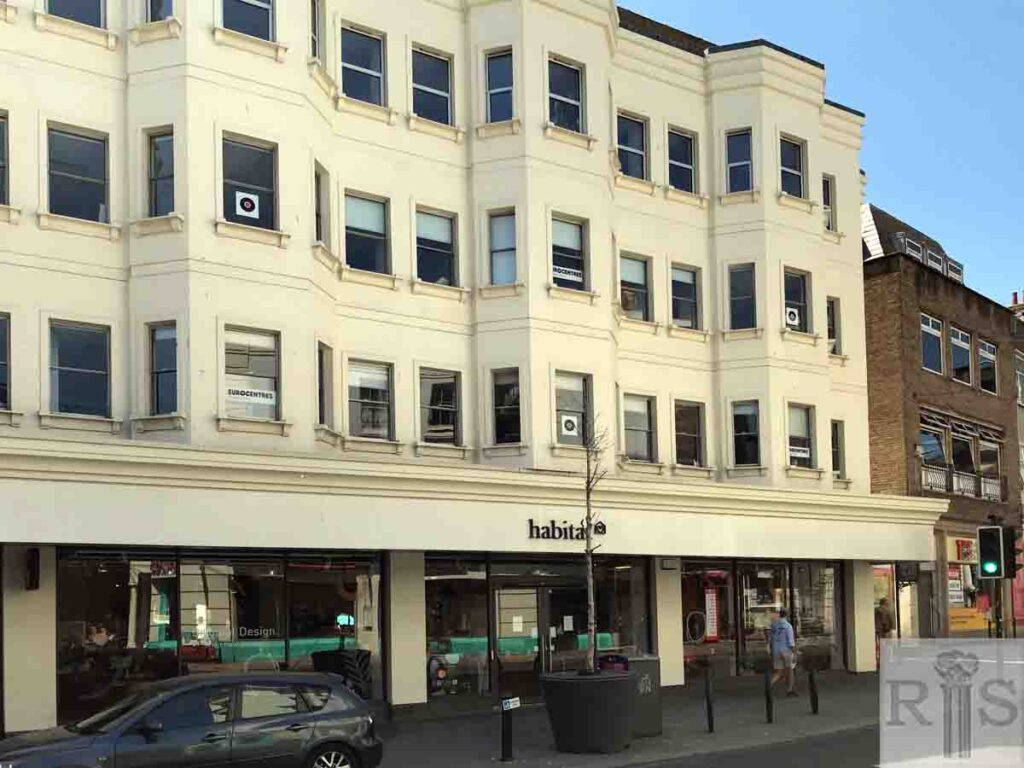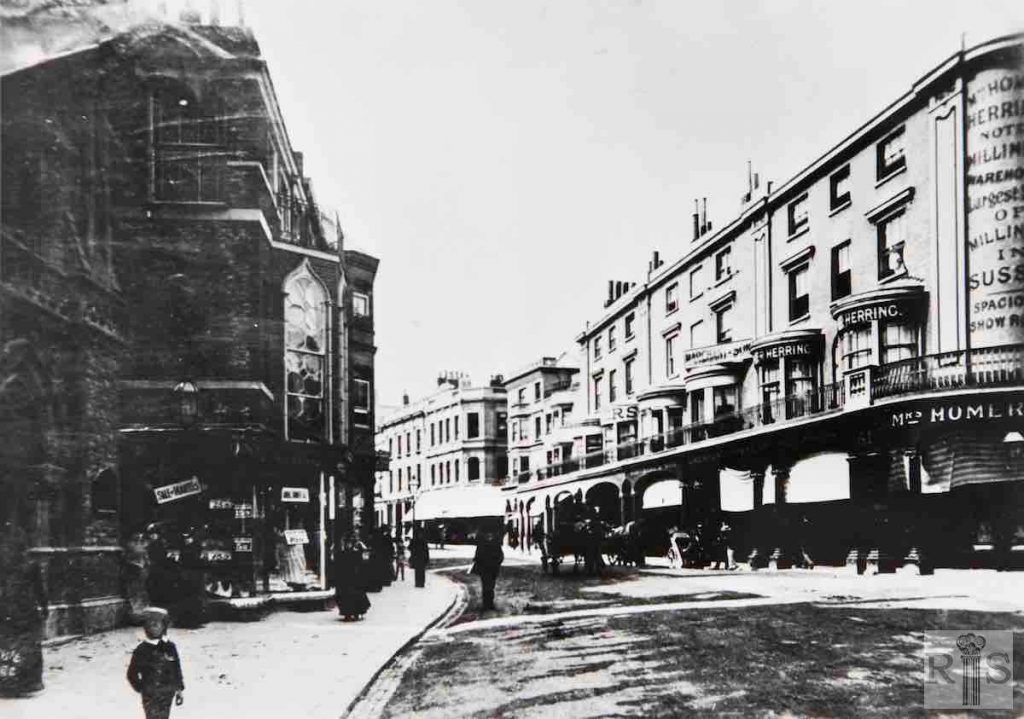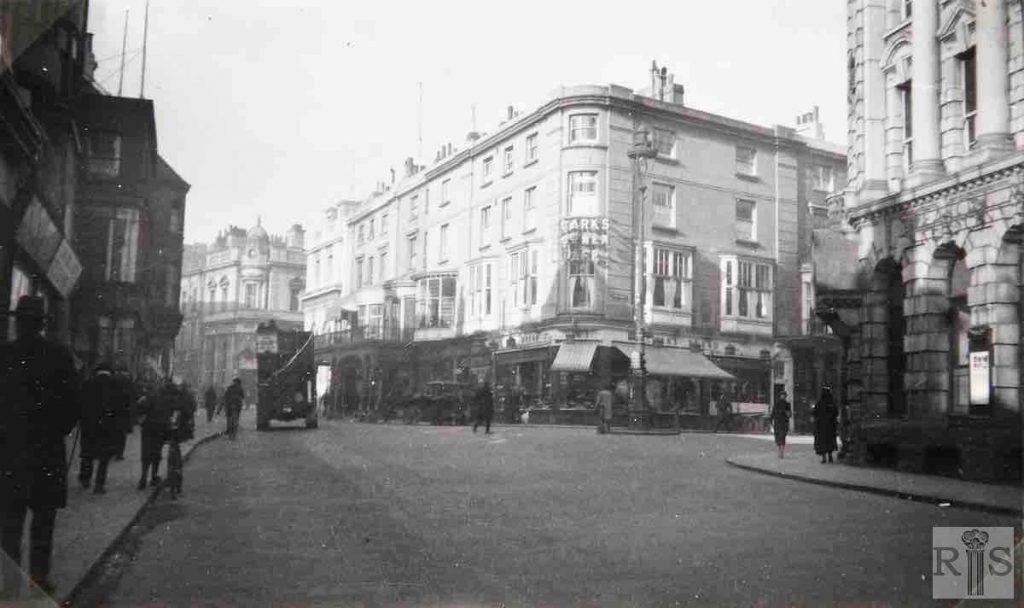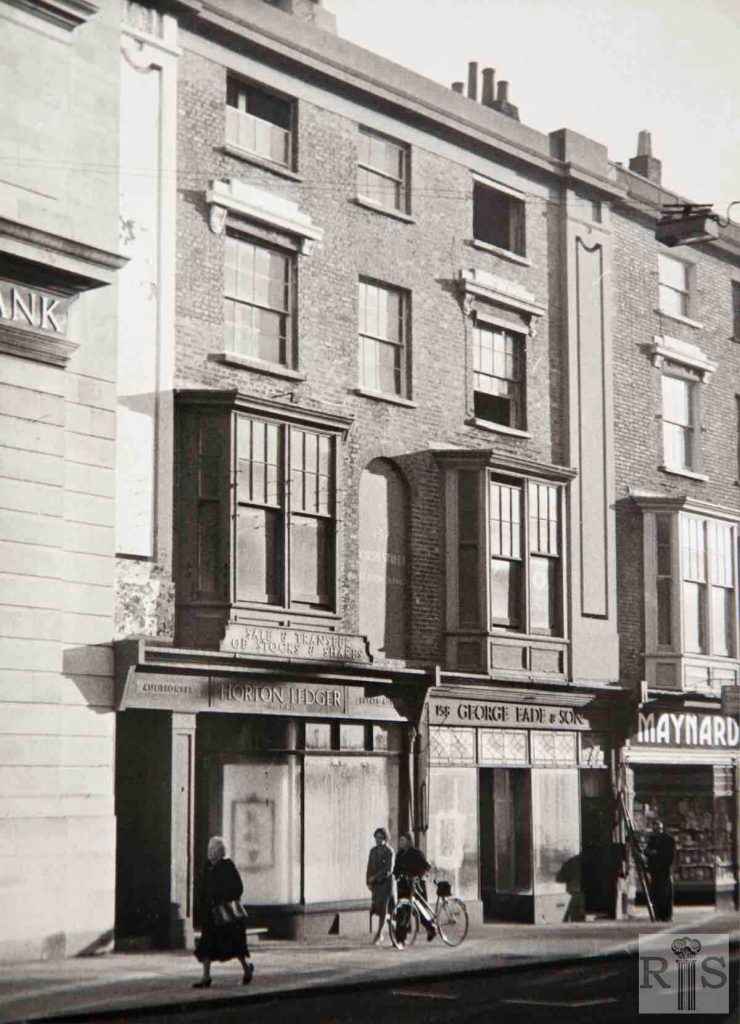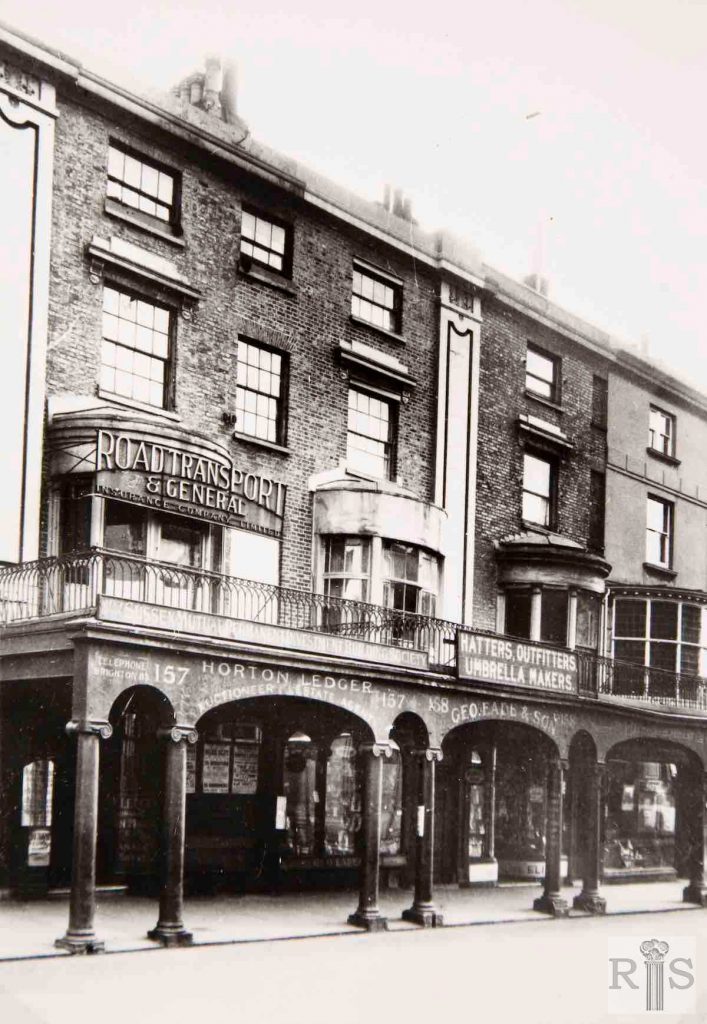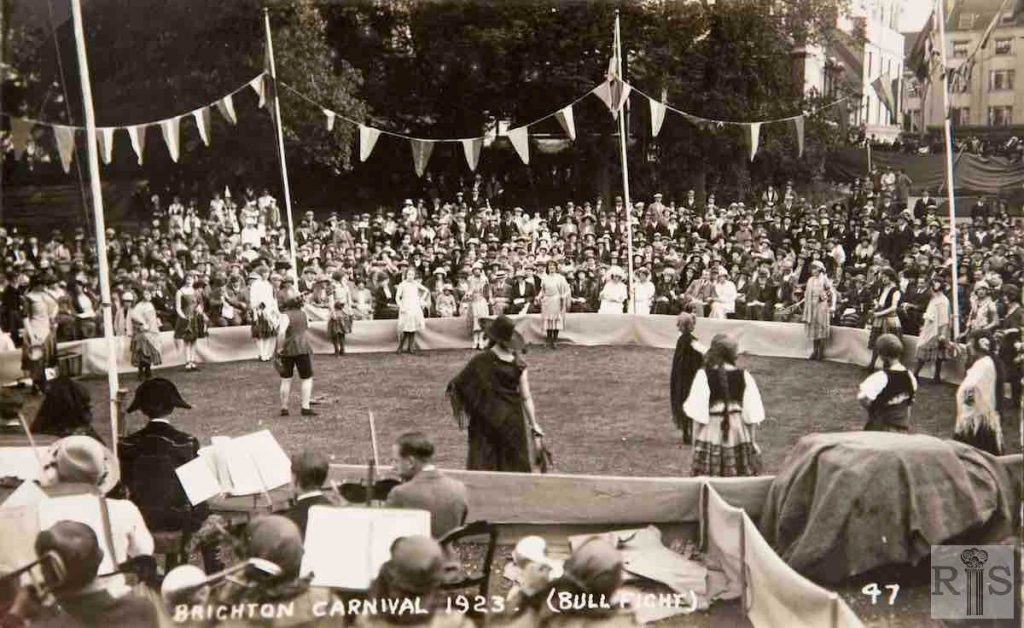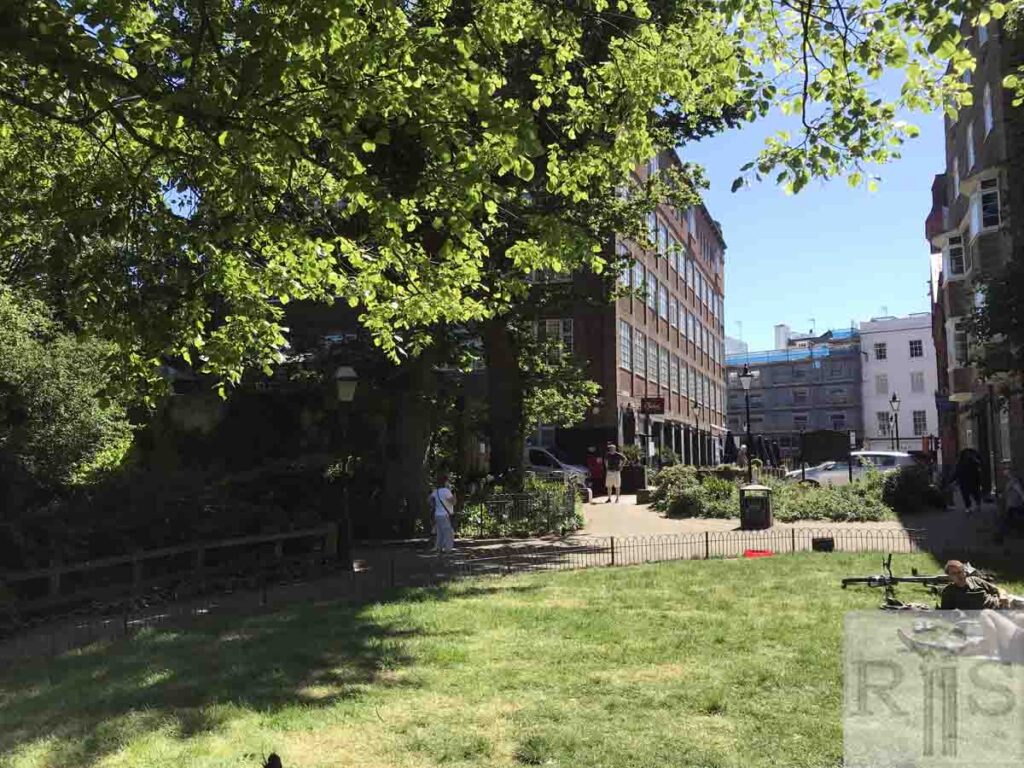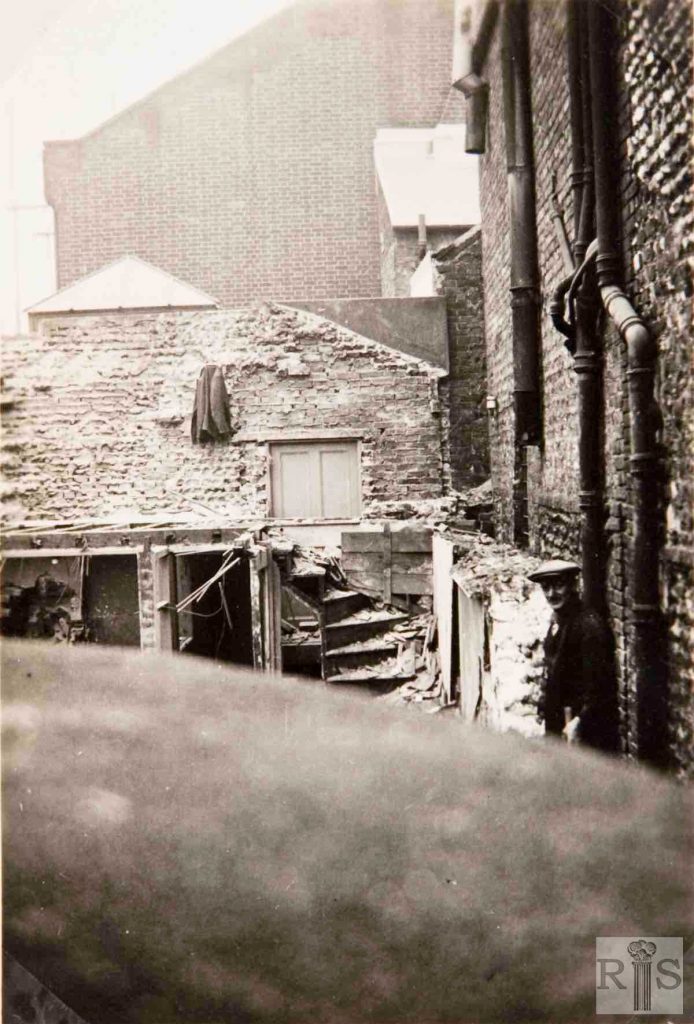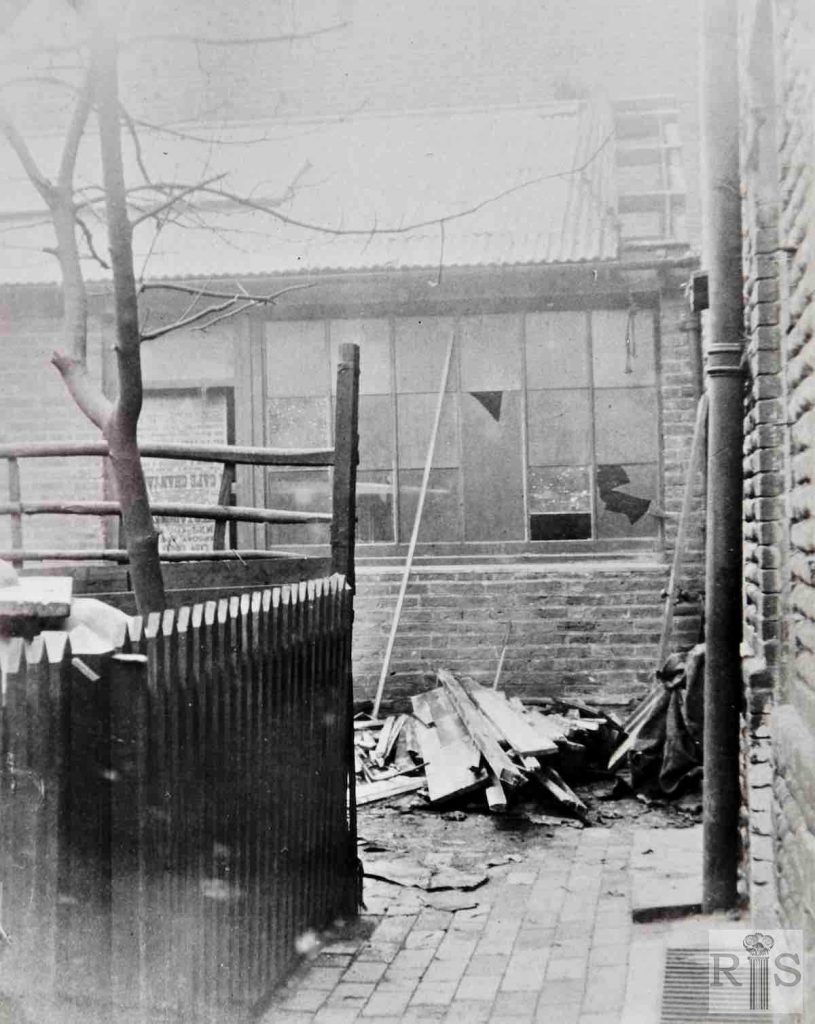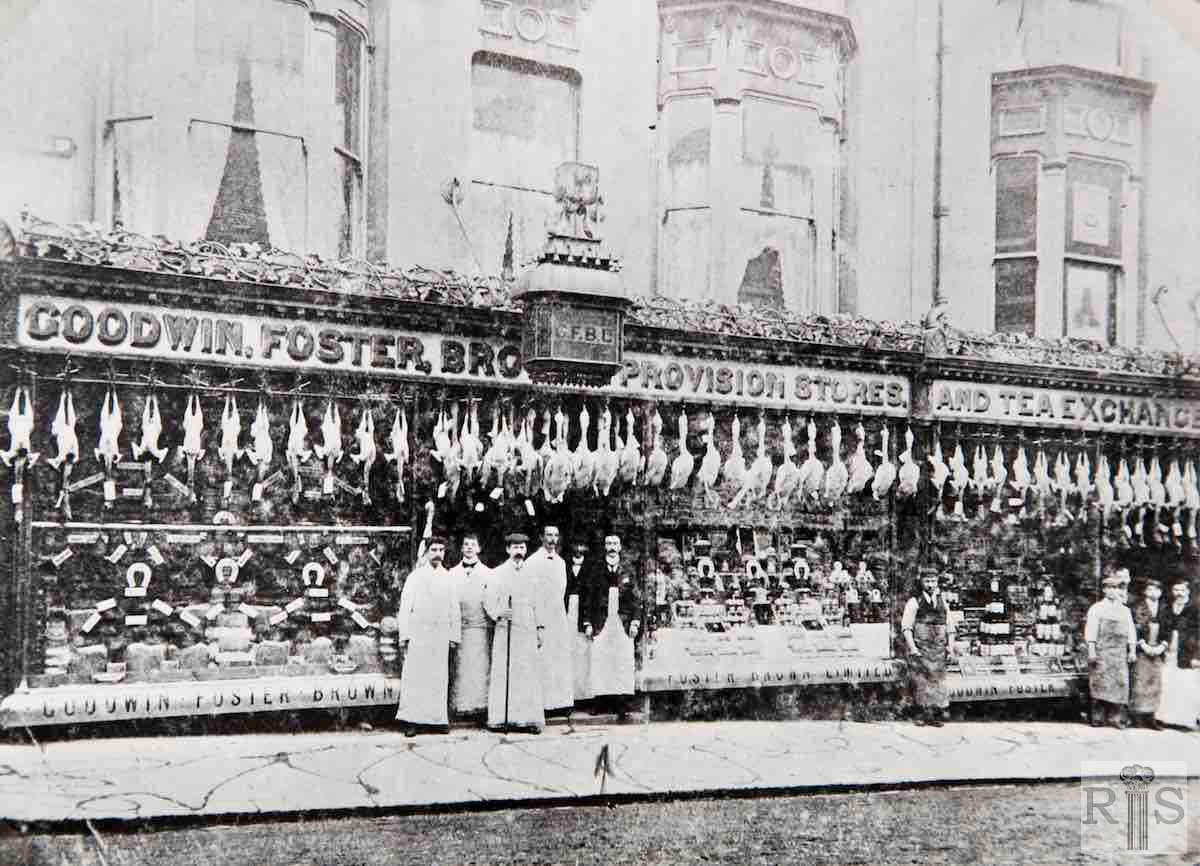
James Gray: 139-142 North Street, between Portland Street and King Street. The Blacksmith’s Arms was originally part of a farmhouse and took its name from a smithy which existed behind it in King Street. It had been occupied as an inn since 1800, if not earlier. The block was demolished in 1938, since when this site has been vacant. Additional Information: This site is, in 2009, now occupied by Barclays Bank. jgc_21_066
James Gray: A block to the east, at the corner of King Street, was the provision store of Goodwin, Foster and Brown. Photographed at the turn of the century, the shop closed about 1904 and the Prudential Assurance Company’s offices were built here, being opened in 1906. The new building was set back from the others, this being the first widening in this part of North Street. jgc_21_070
2019: A magnificent display of game has now been replaced by a rather dull building. (Photographer: Simon Cooper)
James Gray: The original Prudential Assurance Company’s offices, just east of King Street, about 1962. Built to the design of Waterhouse in the favoured red brick and terracotta this was a substantial building which houses many other small offices. Erected in 1906 it had a life of just over 60 years, being demolished in 1967 and replaced by the present greatly extended building. jgc_21_073
2019: The distinctive commercial building in the original image no longer exists. (Photographer: Simon Cooper)
James Gray: The firm of W J Smith, Booksellers, occupied No 43 from 1858 to 1912, after which for many years it was a tailors shop, but now, in 1954, it is again a Booksellers. jgc_21_082
2020: 41-43 North Street is now the home of The Body Shop. The shop frontage has changed but there have been few changes to the upper floor. (Photographer: Mike Doodson)
James Gray: The originals of these two old photographs [jgc_21_083 and 084], said to have been taken in 1864, show the rear of W J Smith’s premises at 41-43 North Street. This photograph shows the workshops at the rear of Smith’s premises, and presumably backing onto Duke’s Passage, but one cannot be sure of this. Note the clarity of the boys’ features and their dress, for such an early photograph. jgc_21_083
James Gray: The originals of these two old photographs [jgc_21_083 and 084], said to have been taken in 1864, show the rear of W J Smith’s premises at 41-43 North Street. To the left, the opening into Duke’s Passage. Parts of the old flint wall still remain now, 120 years later. jgc_21_084
James Gray: Two processions [jgc_21_085 and 086] at the lower end of the street, this one being during the visit of the Shah of Persia in 1889. jgc_21_085
James Gray: In this scene Sir Douglas Haig, later Lord Haig, came to Brighton on 30 November 1920 to receive the Freedom of the Town. jgc_21_086
James Gray: A photograph showing the full extent of the Colonnade from 157, North Street round to and beyond the Theatre Royal. Period about 1910. jgc_21_088
2020: The Colonnade now only extends along the southern end of New Road. The North Street part of the Colonnade was removed in the 1920s, the last section in 1929 as part of the North Street widening scheme. (Photographer: Mike Doodson)
James Gray: The premises of the London & Midland Bank (later Midland Bank) 38 North Street, at the corner of Ship Street, in 1896. The bank opened its branch here in 1893, but only stayed until 1903 before moving across North Street to its present site on the corner of Bond Street. Previously the premises had been put to a variety of uses such as a baker’s shop, booksellers and a music warehouse, but since the bank moved it has chiefly been used as a ladies costumiers. jgc_21_089
James Gray: In this year the building was threatened with destruction. A proposal was made that part of the widening of North Street should be carried out on the south side of the street, which would have meant the demolition of these premises. It will be seen that one of the bills states that the building is coming down, while the large hoarding refers to a temporary extension of lease and proclaims that the building is not coming down yet. In 1956 it is still there, just the same as it was in 1931! jgc_21_090
James Gray: Vokins shop in North Street, about 1896, before the extension towards Ship Street. Next door to Vokins was the office of the old Brighton Guardian newspaper and, beyond that, old houses that were later refaced. jgc_21_091
James Gray: Vokins store 32-36 North Street, just before the reconstruction of the premises was undertaken. The narrow entrance to Elm Tree Cottages was between Nos 36 and 37 almost opposite the traffic light standard. jgc_21_092
2020: The whole block of buildings between the former Clarence Hotel (in 1896 containing the Leeson and Vokins store and some smaller shops) and the corner of Ship Street have been replaced by a single building. TK Maxx is the largest shop in 2020 on the right of the picture. (Photographer: Mike Doodson)
James Gray: This was on the site of Vokins top shop near Ship Street. Mr Morgan occupied it from 1889 until 1912. Vokins did not occupy the shop until 1932 and the building was demolished when Vokins premises were completely rebuilt in 1934. jgc_21_097
2020: The whole building in this block (east of Ship Street) has been replaced. No 35 would have been roughly where Size? shoe store is in 2020. (Photographer: Mike Doodson)
James Gray: These photographs show the adjoining buildings 27-31 North Street. Above are the premises of W Davis & Sons, established here in the 1860s and still occupied by this family business in 1956. Next door was the Coach and Horses Inn, one of Brighton’s oldest taverns, which closed in 1927. jgc_21_100
2020: The two old buildings have been replaced by one modern one. Today the 1 Stop Travel centre is located on the former site of W Davis, while a pizza restaurant has replaced the Coach and Horses. The high wall and chimney stack of the former Clarence Hotel is visible on the right in both the 1919 and 2020 images. (Photographer: Mike Doodson)
James Gray: The focal point of these three photographs [jgc_21_105, 106 and 107], dating from about 1870, is the Clarence Hotel, while the following ones provide a good view of North Street from Bond Street almost up to the Clock Tower. Note the extremely dirty condition of the roads and the cobbled crossing, kerbs and gutter channels. jgc_21_105
James Gray: [See caption for jgc_21_105 above.] jgc_21_106
James Gray: [See caption for jgc_21_105 above.] jgc_21_107
James Gray: The Clarence Hotel was built in 1785 as the New Inn. The eastern bar, now the saloon, was then known as the Clarence Shades. Note Stafford’s van, an early Ford, outside the hotel. jgc_21_101
James Gray: The focal point of these photographs is the Clarence Hotel. The old hotel, empty with its future in doubt, photographed on 10 July 1977. The fears that this eighteenth century building might be demolished were allayed when a building society bought the building for offices. jgc_21_102
James Gray: A photograph taken from the rear of the Hotel, in Clarence Yard, and dating from about 1905. The tall building at the rear may well have been at one time the Model Dwellings, artisans’ flats, which were here for about fifty years from the 1850s. jgc_21_104
2020: The Clarence Hotel building has been unoccupied for some years. It has recently been in the news as a result of a 23 year old man being found dead inside the empty building. The former saloon bar (ground floor to the left of the main door) is occupied by a souvenir shop called Jack’s of Brighton. (Photographer: Mike Doodson)
James Gray: There is no evidence of the date of this photograph, but probably the period is between 1900 and 1910. Here were the offices of the Brighton Gazette. The Editor, W J Towner, is the man in the trap wearing the top hat. The part of the ground floor occupied by the Yorkshire Coal Company was numbered 150a. jgc_21_108
James Gray: The same building, 50 years later. In 1910 the ground floor became the Cinema de Luxe and continued as such until a serious fire just before the 1939-1945 War. Since then it has remained boarded up and derelict. The announcement about the new cinema can be discounted, as before long the buildings will be demolished for street widening. Photograph taken on 16 December 1959. jgc_21_109
James Gray: Three photographs [jgc_21_110, 111 and 112], probably taken during the 1950s, of the shops and business premises between King Street and Bond Street. Except for the Midland Bank, all these buildings have now gone. They were started at the far left – Nos 143-144, Prudential Assurance Co. (the old 1906 building, not the later one), Nos 145-146, John Gilkes & Sons, paint and wallpaper merchants, No 147, Parsons Son & Basley, estate agents, No 148, a jewellery shop, No 149, Dixeys Ltd, opthalmic opticians next door, the remains of the old Cinema de Luxe, and finally, the Midland Bank. There were several offices in the upstairs rooms of some buildings. jgc_21_111 and 099
2020: The sequence of old shops has been replaced by a modern block incorporating a Premier Inn hotel and numerous shops at pavement level. (Photographer: Mike Doodson)
James Gray: After causing a traffic bottleneck for 25 years, dilapidated old buildings, 148-150 North Street, were at last demolished in February 1962, and the roadway widened. As the neighbouring site between Portland Street and King Street remained empty for 19 years (1938-57) it is to be hoped that this cleared space will not remain a car park until 1981. jgc_21_113
2020: The sequence of old shops has been replaced by a modern block incorporating a Premier Inn hotel and numerous shops at pavement level. The Midland Bank (now HSBC) building is still there, on the right of the photograph. (Photographer: Mike Doodson)
James Gray: Demolition of 148-150 North Street, in February 1962. jgc_21_115
James Gray: Demolition of 148-150 North Street, in February 1962, and a summer photograph [jgc_21_118] taken later the same year. jgc_21_117
James Gray: The cleared site was used for some years as a car park before the large office building was erected for the Prudential Assurance Co. Additional Information: The building is now an hotel. jgc_21_118
James Gray: More scenes of the removal of 148-150 North Street on 10 February 1962. This view is from the back yard looking right through the building into North Street. jgc_21_119
James Gray: Another scene of the removal of 148-150 North Street on 10 February 1962. jgc_21_120
James Gray: The view along New Road, showing the Colonnade extending from opposite the second house to the Theatre Royal and beyond. It was removed from in front of 2, 3 and 4 New Road in 1931 and is still unchanged now, 25 years later. Additional Information: Partially restored, early 2000s. jgc_21_123
2020: No comment. (Photographer: Mike Doodson)
James Gray: The last of the Coach and Horses. This photograph of 1927 shows this old inn just after it had closed to the public for the last time. Note the small ‘closed’ sign on each door. This was an eighteenth century inn where, as long ago as 1785, cock-fighting was being held. Originally built in the style of the old houses adjoining to the east, the frontage was rebuilt in 1870 and remains almost unchanged to this day. Richard Mose was the last licensee. jgc_21_124
2020: A relatively modern block with an Italian restaurant at street level has replaced the Coach and Horses. (Photographer: Mike Doodson)
James Gray: Demolition of the colonnade in progress, in North Street between Bond Street and New Road. This necessitated the removal of the bow windows on the first floor, after which the façades were redesigned in their present form. jgc_21_125
James Gray: An enlargement of the small photograph on the previous page. I have now established that this work was carried out at a weekend, to avoid too much interference with traffic in North Street. The photograph was taken on Saturday 29 June 1929 and work finished on the following day. jgc_21_126
James Gray: 26-29 North Street, photographed in 1947. This is part of the really old North Street. The building on the left, built early in the last century, was for many years occupied as a foundry and there was a forge at the rear. It has since been removed to make way for Martins Bank. Nos 27 and 28 have been unchanged for years and the remains of the old gas lamp can still be seen. The next building was the old inn, the Coach and Horses, dating from the eighteenth century and occupied as a tavern until 1927. jgc_21_127
James Gray: The reverse view of these two buildings (26-29 North Street), seen from the alley which bisects Meeting House Lane, formerly known as Poplar Place. The flint walls and leaning chimney stacks testify to the age of these buildings, which were removed just a few years ago. jgc_21_128
2020: All the buildings in the 1947 photo have been demolished and replaced by these relatively modern buildings, now occupied by 1 Stop Travel Shop. (Photographer: Mike Doodson)
James Gray: Two [identical] photographs of Leeson & Vokins shop at 21-22 North Street. jgc_21_140
James Gray: The lower shop of Leeson and Vokins, 1897, previously Sturt and Sons. [image identical to jgc_21_140 above] jgc_21_045
2020: The current building on this site, Huntingdon House, incorporating a branch of Habitat as shown, replaced both the Countess of Huntingdon’s chapel (see jgc_21_122) and the Leeson and Vokins store at Nos 21 and 22 (not to be confused with another branch of Leeson and Vokins further up North Street at Nos 32-35). (Photographer: Mike Doodson)
James Gray: The last part of the colonnade which stood in front of the three shops shown here was removed in 1929. Photographed on 13 December 1959, these buildings, Nos 157 and 158, were later demolished for an extension of the National Provincial Bank. jgc_21_087
James Gray: This photograph is earlier, but of unknown period, probably 1880s, when the shop premises were occupied by Henry Sturt. It gives a good view of the extent of the colonnade and of the corner building replaced by the National Provincial Bank. jgc_21_141
James Gray: North from New Road, in 1928. The remaining portion of the colonnade was removed from North Street in the following year. jgc_21_162
James Gray: 157-158-159 North Street, before the removal of the Colonnade later in the same year. The Royal Colonnade, as it was originally called, was built in 1823 and extended from North Street round into New Road to beyond the Theatre Royal. Other parts of this Colonnade were removed earlier in the century. Reproduced by kind permission of Messrs. Geo. Eade & Son. jgc_21_121
James Gray: At first sight this photograph of the Brighton carnival, in June 1923, seems to have nothing to do with North Street, but look a little closer. The event took place on the Pavilion lawns at the end of Princes Place, and behind the awning can be seen the shops on the south side of North Street, one of them being that of Glasyer & Kemp, Chemists, who then occupied Nos 11 and 12. jgc_21_144
James Gray: Demolition of Elm Tree Cottages. These ancient cottages which dated from the 17th century were hidden away behind the high walls of North Street and Ship Street, and were approached by a very narrow passage. One cottage was still occupied as lately as 1926. jgc_21_093
James Gray: Unfortunately these photographs [jgc_21_094 and jgc_21_095] show us little of these ancient cottages which were hidden from view behind Vokins Store. On the right foreground is the flint wall and roof of one cottage, probably then the only one remaining. This view is to the west looking to Ship Street – the gap is the entrance to Lewis’s Buildings. jgc_21_094
James Gray: Unfortunately these photographs [jgc_21_094 and jgc_21_095] show us little of these ancient cottages which were hidden from view behind Vokins Store.

